Feasibility Report for Online Marketing and Delivery System for Rays Organization
VerifiedAdded on 2023/06/07
|29
|6053
|465
AI Summary
This report is to find out feasibility report of project plan installing online marketing and delivery system for Rays organization. The report includes project needs, objectives, critical success factors, organizational changes, option analysis, projection, project approach, budget, risk and program related to the project. The recommended option is to make alternative solution, reassess the feasibility of the online system and determine the cost. The project plan has major dependency on the internet system and requires project insight and projecting management software to deliver the products properly.
Contribute Materials
Your contribution can guide someone’s learning journey. Share your
documents today.
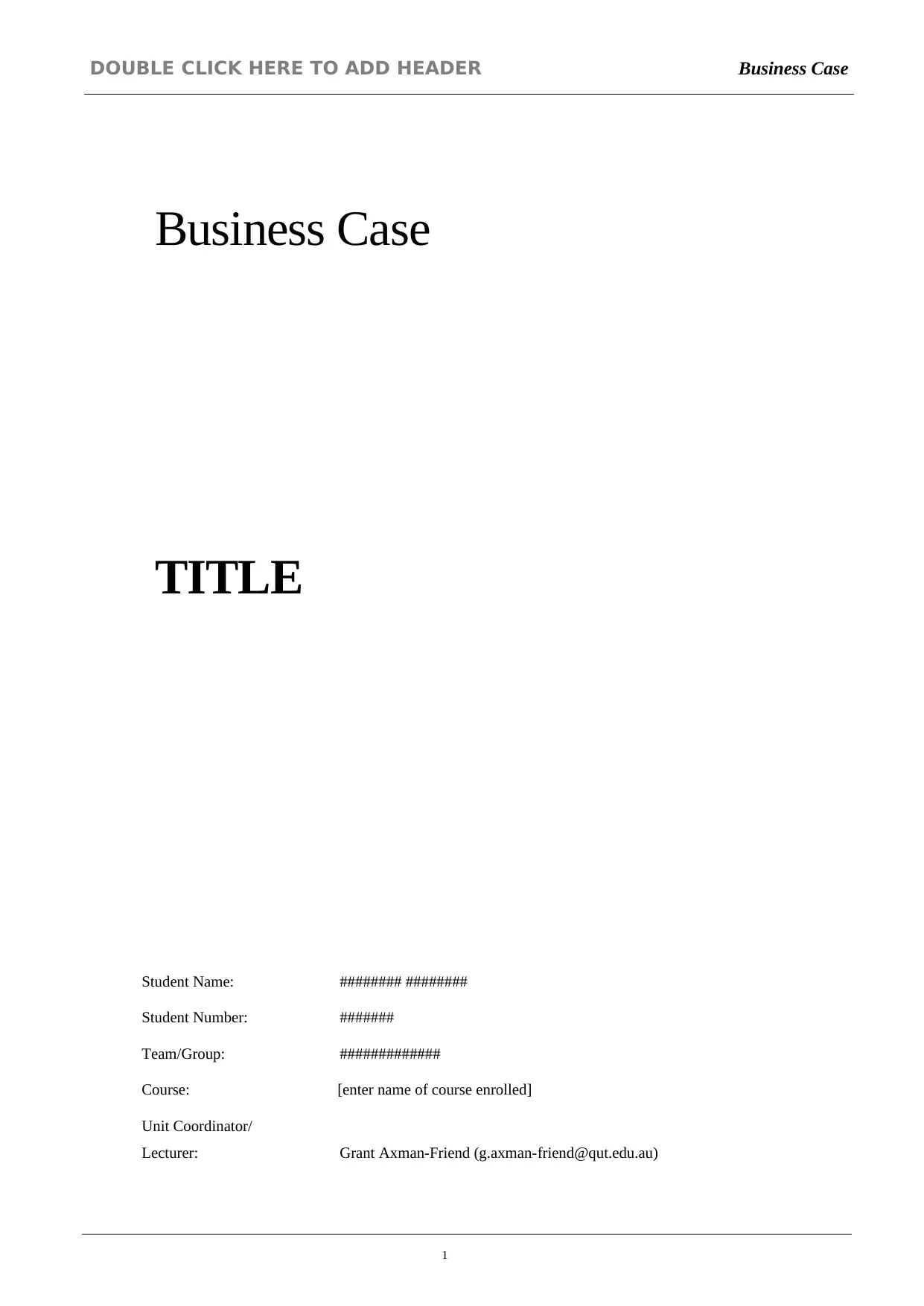
DOUBLE CLICK HERE TO ADD HEADER Business Case
Business Case
TITLE
Student Name: ######## ########
Student Number: #######
Team/Group: #############
Course: [enter name of course enrolled]
Unit Coordinator/
Lecturer: Grant Axman-Friend (g.axman-friend@qut.edu.au)
1
Business Case
TITLE
Student Name: ######## ########
Student Number: #######
Team/Group: #############
Course: [enter name of course enrolled]
Unit Coordinator/
Lecturer: Grant Axman-Friend (g.axman-friend@qut.edu.au)
1
Secure Best Marks with AI Grader
Need help grading? Try our AI Grader for instant feedback on your assignments.

DOUBLE CLICK HERE TO ADD HEADER Business Case
Institution: Queensland University of Technology
Teaching Period: [enter semester and year]
2
Institution: Queensland University of Technology
Teaching Period: [enter semester and year]
2
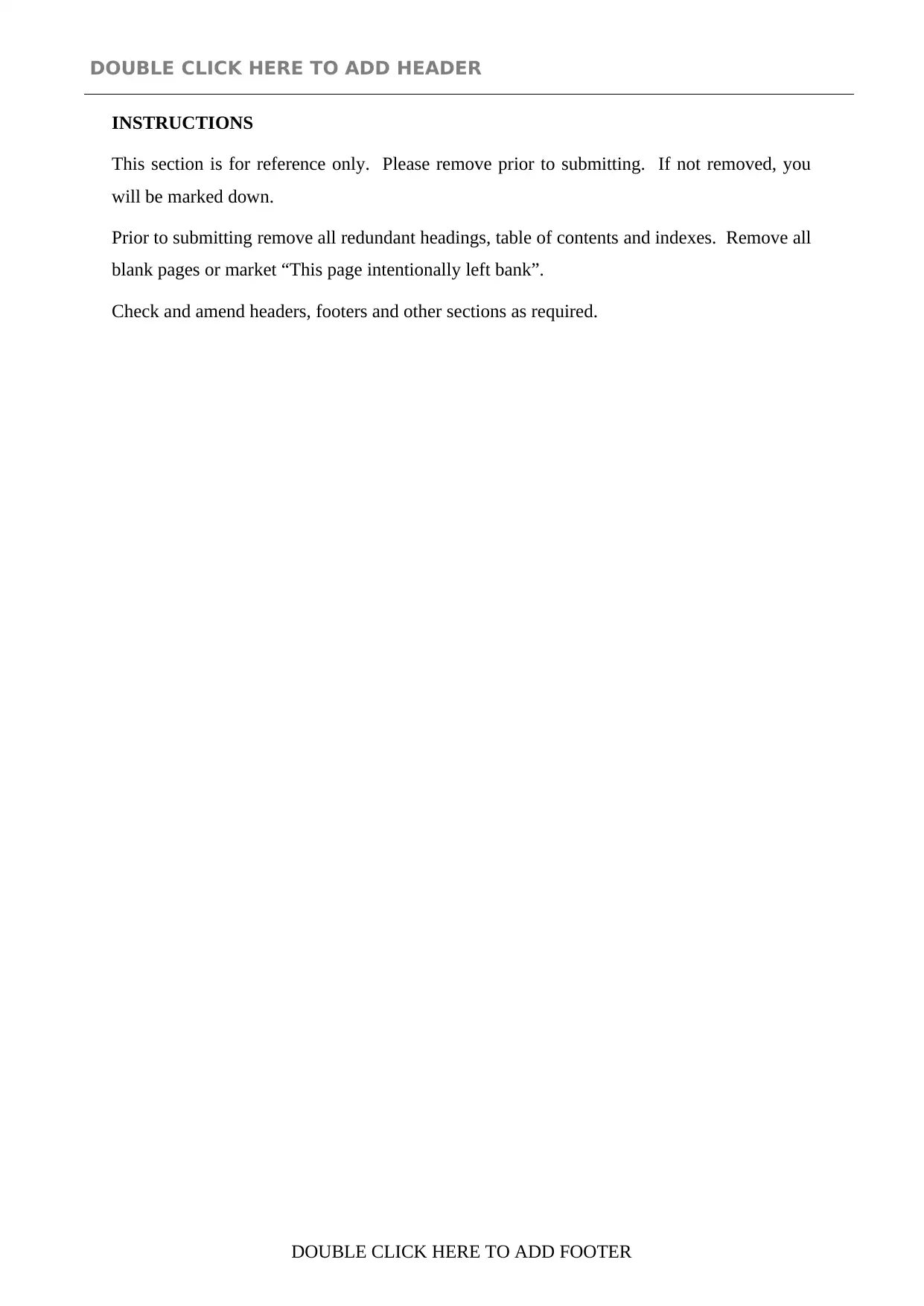
DOUBLE CLICK HERE TO ADD HEADER
INSTRUCTIONS
This section is for reference only. Please remove prior to submitting. If not removed, you
will be marked down.
Prior to submitting remove all redundant headings, table of contents and indexes. Remove all
blank pages or market “This page intentionally left bank”.
Check and amend headers, footers and other sections as required.
DOUBLE CLICK HERE TO ADD FOOTER
INSTRUCTIONS
This section is for reference only. Please remove prior to submitting. If not removed, you
will be marked down.
Prior to submitting remove all redundant headings, table of contents and indexes. Remove all
blank pages or market “This page intentionally left bank”.
Check and amend headers, footers and other sections as required.
DOUBLE CLICK HERE TO ADD FOOTER
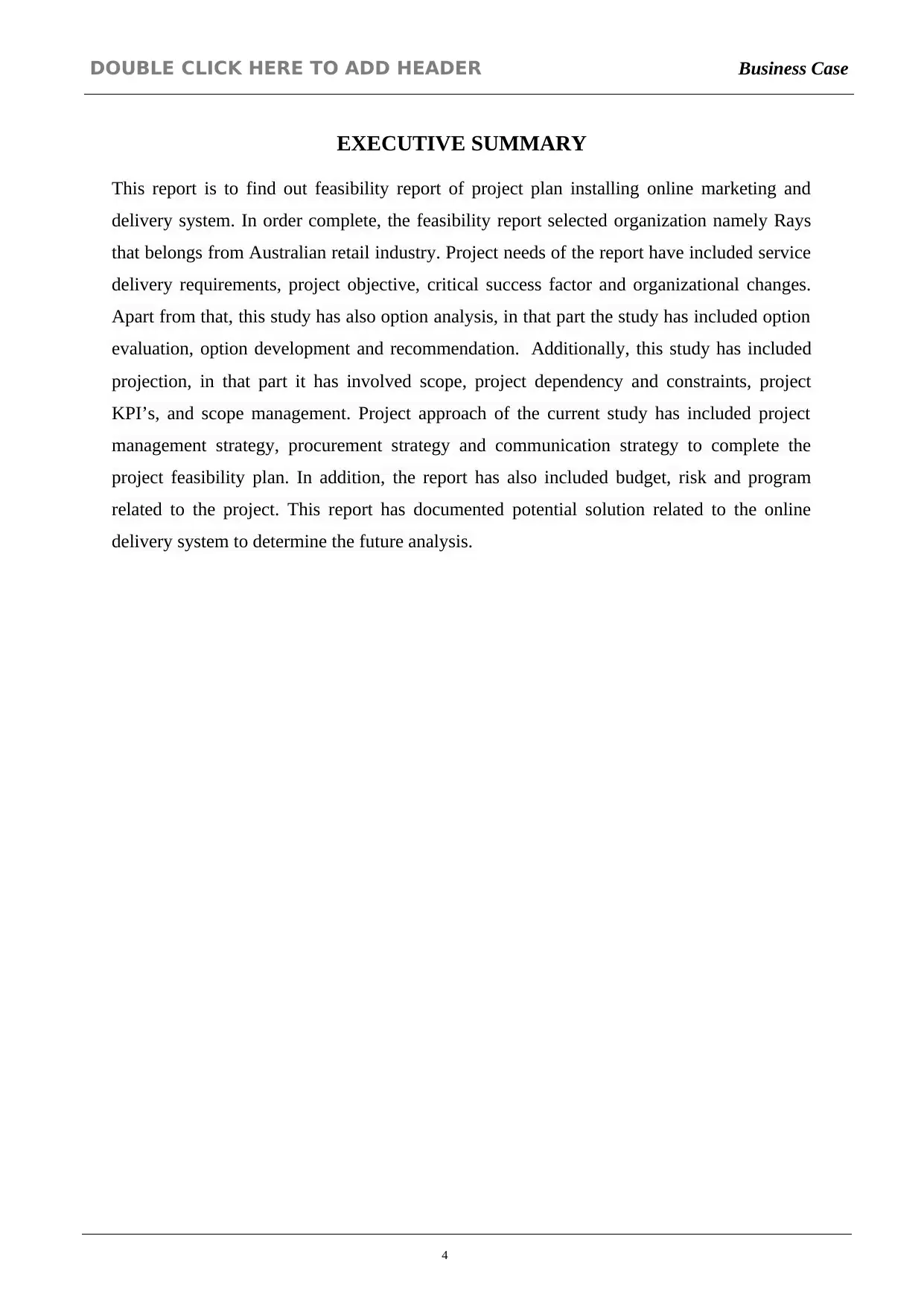
DOUBLE CLICK HERE TO ADD HEADER Business Case
EXECUTIVE SUMMARY
This report is to find out feasibility report of project plan installing online marketing and
delivery system. In order complete, the feasibility report selected organization namely Rays
that belongs from Australian retail industry. Project needs of the report have included service
delivery requirements, project objective, critical success factor and organizational changes.
Apart from that, this study has also option analysis, in that part the study has included option
evaluation, option development and recommendation. Additionally, this study has included
projection, in that part it has involved scope, project dependency and constraints, project
KPI’s, and scope management. Project approach of the current study has included project
management strategy, procurement strategy and communication strategy to complete the
project feasibility plan. In addition, the report has also included budget, risk and program
related to the project. This report has documented potential solution related to the online
delivery system to determine the future analysis.
4
EXECUTIVE SUMMARY
This report is to find out feasibility report of project plan installing online marketing and
delivery system. In order complete, the feasibility report selected organization namely Rays
that belongs from Australian retail industry. Project needs of the report have included service
delivery requirements, project objective, critical success factor and organizational changes.
Apart from that, this study has also option analysis, in that part the study has included option
evaluation, option development and recommendation. Additionally, this study has included
projection, in that part it has involved scope, project dependency and constraints, project
KPI’s, and scope management. Project approach of the current study has included project
management strategy, procurement strategy and communication strategy to complete the
project feasibility plan. In addition, the report has also included budget, risk and program
related to the project. This report has documented potential solution related to the online
delivery system to determine the future analysis.
4
Secure Best Marks with AI Grader
Need help grading? Try our AI Grader for instant feedback on your assignments.
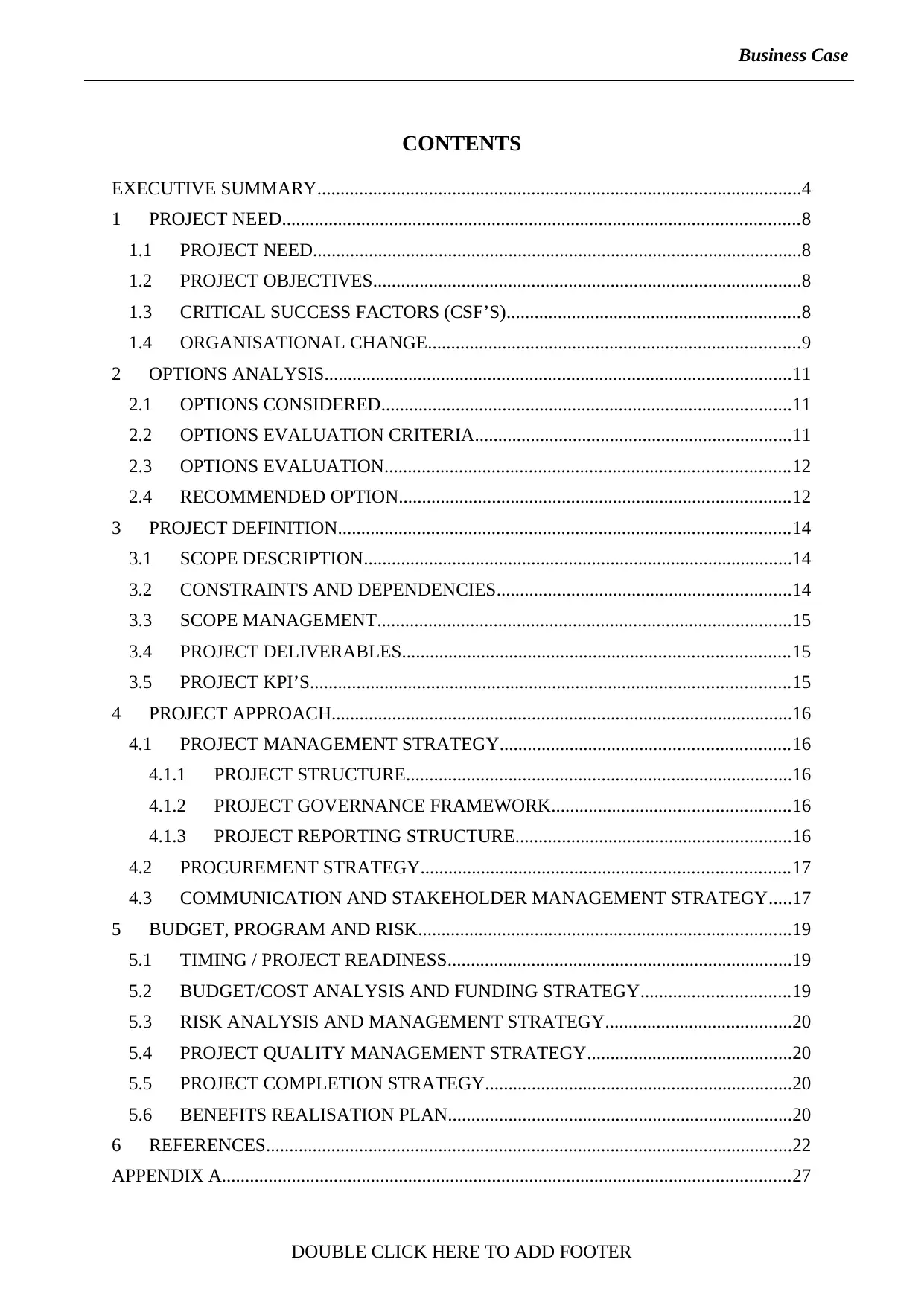
Business Case
CONTENTS
EXECUTIVE SUMMARY........................................................................................................4
1 PROJECT NEED...............................................................................................................8
1.1 PROJECT NEED.........................................................................................................8
1.2 PROJECT OBJECTIVES............................................................................................8
1.3 CRITICAL SUCCESS FACTORS (CSF’S)...............................................................8
1.4 ORGANISATIONAL CHANGE................................................................................9
2 OPTIONS ANALYSIS....................................................................................................11
2.1 OPTIONS CONSIDERED........................................................................................11
2.2 OPTIONS EVALUATION CRITERIA....................................................................11
2.3 OPTIONS EVALUATION.......................................................................................12
2.4 RECOMMENDED OPTION....................................................................................12
3 PROJECT DEFINITION.................................................................................................14
3.1 SCOPE DESCRIPTION............................................................................................14
3.2 CONSTRAINTS AND DEPENDENCIES...............................................................14
3.3 SCOPE MANAGEMENT.........................................................................................15
3.4 PROJECT DELIVERABLES...................................................................................15
3.5 PROJECT KPI’S.......................................................................................................15
4 PROJECT APPROACH...................................................................................................16
4.1 PROJECT MANAGEMENT STRATEGY..............................................................16
4.1.1 PROJECT STRUCTURE...................................................................................16
4.1.2 PROJECT GOVERNANCE FRAMEWORK...................................................16
4.1.3 PROJECT REPORTING STRUCTURE...........................................................16
4.2 PROCUREMENT STRATEGY...............................................................................17
4.3 COMMUNICATION AND STAKEHOLDER MANAGEMENT STRATEGY.....17
5 BUDGET, PROGRAM AND RISK................................................................................19
5.1 TIMING / PROJECT READINESS..........................................................................19
5.2 BUDGET/COST ANALYSIS AND FUNDING STRATEGY................................19
5.3 RISK ANALYSIS AND MANAGEMENT STRATEGY........................................20
5.4 PROJECT QUALITY MANAGEMENT STRATEGY............................................20
5.5 PROJECT COMPLETION STRATEGY..................................................................20
5.6 BENEFITS REALISATION PLAN..........................................................................20
6 REFERENCES.................................................................................................................22
APPENDIX A..........................................................................................................................27
DOUBLE CLICK HERE TO ADD FOOTER
CONTENTS
EXECUTIVE SUMMARY........................................................................................................4
1 PROJECT NEED...............................................................................................................8
1.1 PROJECT NEED.........................................................................................................8
1.2 PROJECT OBJECTIVES............................................................................................8
1.3 CRITICAL SUCCESS FACTORS (CSF’S)...............................................................8
1.4 ORGANISATIONAL CHANGE................................................................................9
2 OPTIONS ANALYSIS....................................................................................................11
2.1 OPTIONS CONSIDERED........................................................................................11
2.2 OPTIONS EVALUATION CRITERIA....................................................................11
2.3 OPTIONS EVALUATION.......................................................................................12
2.4 RECOMMENDED OPTION....................................................................................12
3 PROJECT DEFINITION.................................................................................................14
3.1 SCOPE DESCRIPTION............................................................................................14
3.2 CONSTRAINTS AND DEPENDENCIES...............................................................14
3.3 SCOPE MANAGEMENT.........................................................................................15
3.4 PROJECT DELIVERABLES...................................................................................15
3.5 PROJECT KPI’S.......................................................................................................15
4 PROJECT APPROACH...................................................................................................16
4.1 PROJECT MANAGEMENT STRATEGY..............................................................16
4.1.1 PROJECT STRUCTURE...................................................................................16
4.1.2 PROJECT GOVERNANCE FRAMEWORK...................................................16
4.1.3 PROJECT REPORTING STRUCTURE...........................................................16
4.2 PROCUREMENT STRATEGY...............................................................................17
4.3 COMMUNICATION AND STAKEHOLDER MANAGEMENT STRATEGY.....17
5 BUDGET, PROGRAM AND RISK................................................................................19
5.1 TIMING / PROJECT READINESS..........................................................................19
5.2 BUDGET/COST ANALYSIS AND FUNDING STRATEGY................................19
5.3 RISK ANALYSIS AND MANAGEMENT STRATEGY........................................20
5.4 PROJECT QUALITY MANAGEMENT STRATEGY............................................20
5.5 PROJECT COMPLETION STRATEGY..................................................................20
5.6 BENEFITS REALISATION PLAN..........................................................................20
6 REFERENCES.................................................................................................................22
APPENDIX A..........................................................................................................................27
DOUBLE CLICK HERE TO ADD FOOTER
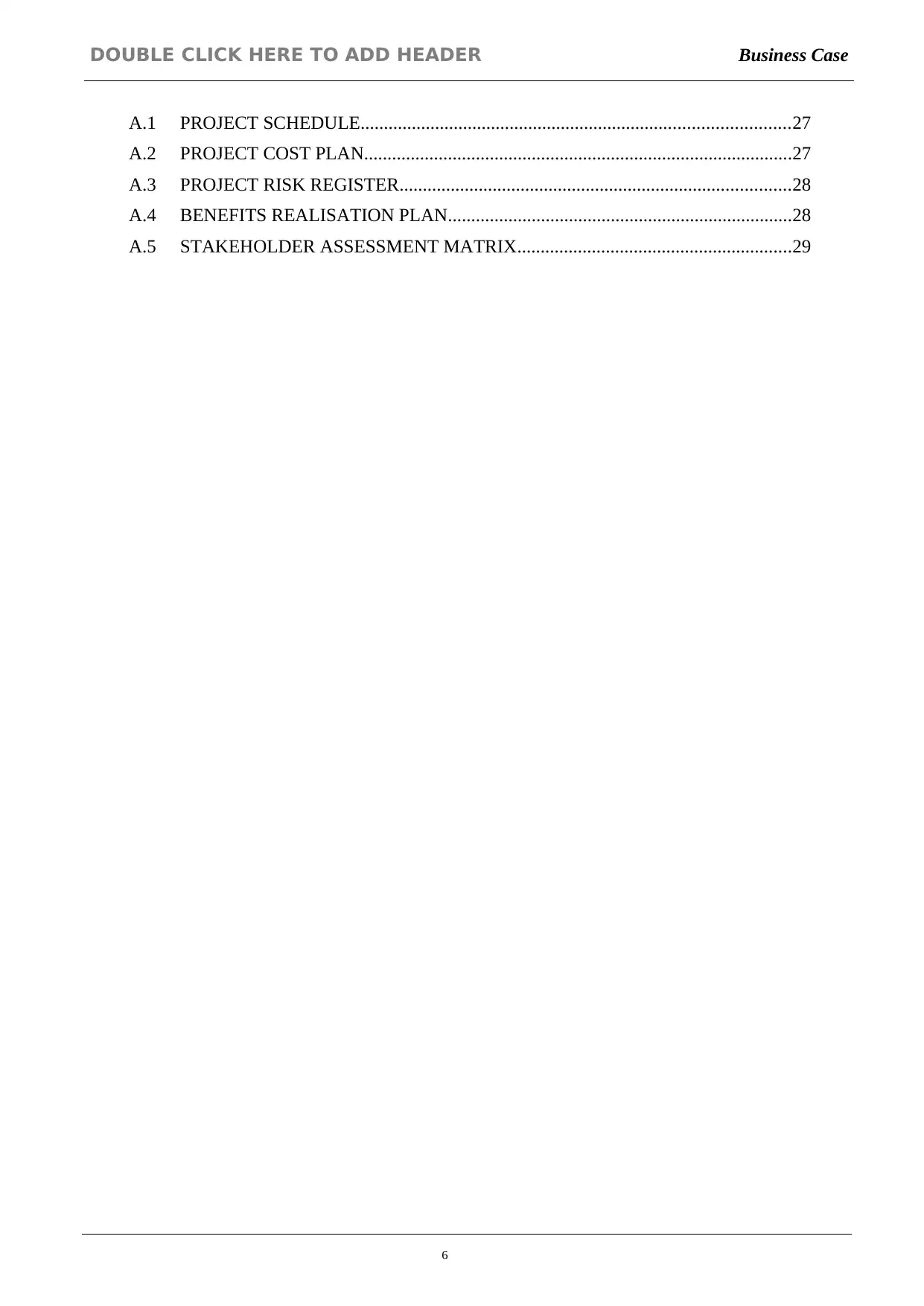
DOUBLE CLICK HERE TO ADD HEADER Business Case
A.1 PROJECT SCHEDULE............................................................................................27
A.2 PROJECT COST PLAN............................................................................................27
A.3 PROJECT RISK REGISTER....................................................................................28
A.4 BENEFITS REALISATION PLAN..........................................................................28
A.5 STAKEHOLDER ASSESSMENT MATRIX...........................................................29
6
A.1 PROJECT SCHEDULE............................................................................................27
A.2 PROJECT COST PLAN............................................................................................27
A.3 PROJECT RISK REGISTER....................................................................................28
A.4 BENEFITS REALISATION PLAN..........................................................................28
A.5 STAKEHOLDER ASSESSMENT MATRIX...........................................................29
6

DOUBLE CLICK HERE TO ADD HEADER Business Case
LIST OF TABLES
Table 2-1 | Project options...............................................................................................................7
Table 2-2 | Table 2 footer example – linked to contents.................................................................7
7
LIST OF TABLES
Table 2-1 | Project options...............................................................................................................7
Table 2-2 | Table 2 footer example – linked to contents.................................................................7
7
Paraphrase This Document
Need a fresh take? Get an instant paraphrase of this document with our AI Paraphraser
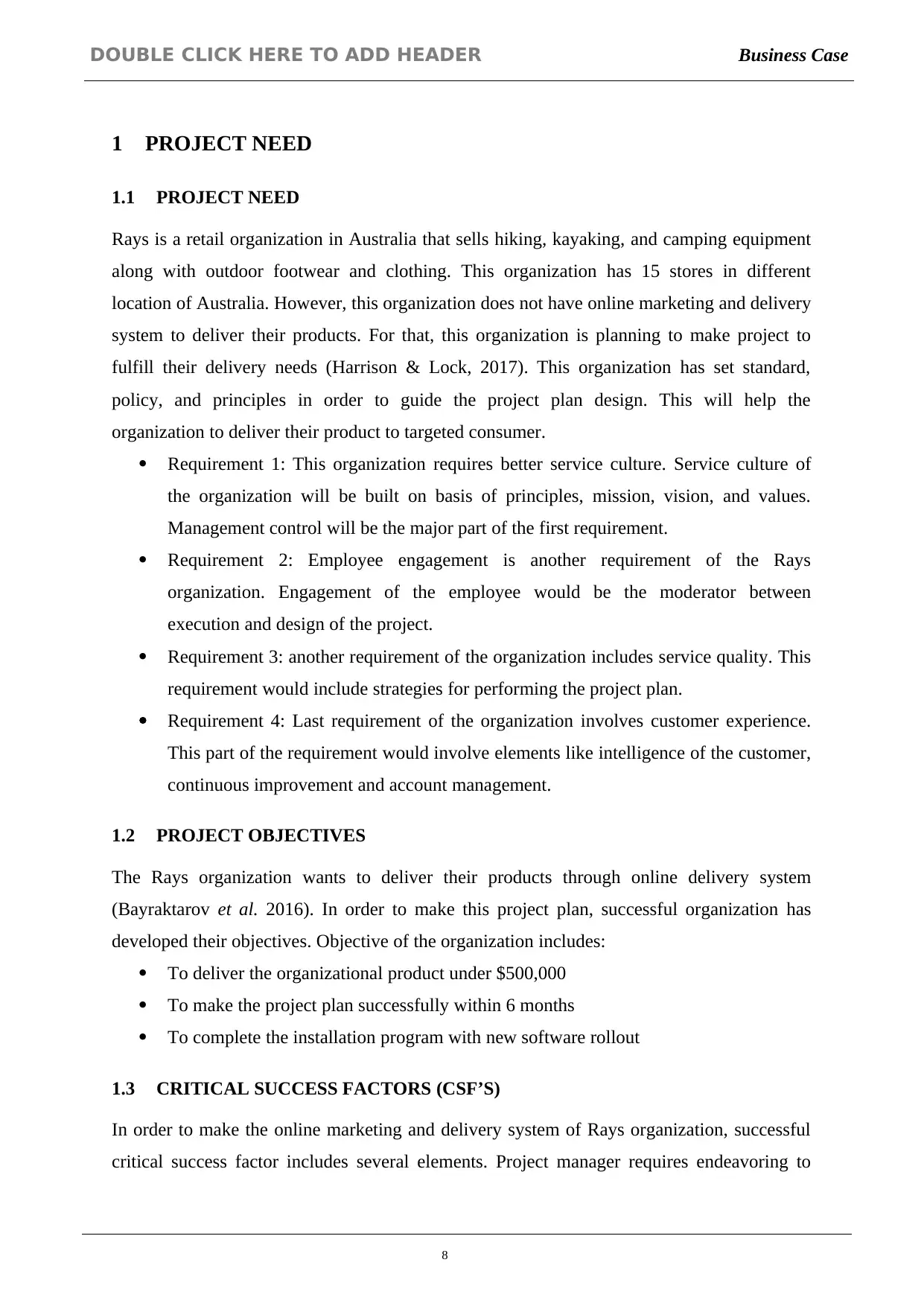
DOUBLE CLICK HERE TO ADD HEADER Business Case
1 PROJECT NEED
1.1 PROJECT NEED
Rays is a retail organization in Australia that sells hiking, kayaking, and camping equipment
along with outdoor footwear and clothing. This organization has 15 stores in different
location of Australia. However, this organization does not have online marketing and delivery
system to deliver their products. For that, this organization is planning to make project to
fulfill their delivery needs (Harrison & Lock, 2017). This organization has set standard,
policy, and principles in order to guide the project plan design. This will help the
organization to deliver their product to targeted consumer.
Requirement 1: This organization requires better service culture. Service culture of
the organization will be built on basis of principles, mission, vision, and values.
Management control will be the major part of the first requirement.
Requirement 2: Employee engagement is another requirement of the Rays
organization. Engagement of the employee would be the moderator between
execution and design of the project.
Requirement 3: another requirement of the organization includes service quality. This
requirement would include strategies for performing the project plan.
Requirement 4: Last requirement of the organization involves customer experience.
This part of the requirement would involve elements like intelligence of the customer,
continuous improvement and account management.
1.2 PROJECT OBJECTIVES
The Rays organization wants to deliver their products through online delivery system
(Bayraktarov et al. 2016). In order to make this project plan, successful organization has
developed their objectives. Objective of the organization includes:
To deliver the organizational product under $500,000
To make the project plan successfully within 6 months
To complete the installation program with new software rollout
1.3 CRITICAL SUCCESS FACTORS (CSF’S)
In order to make the online marketing and delivery system of Rays organization, successful
critical success factor includes several elements. Project manager requires endeavoring to
8
1 PROJECT NEED
1.1 PROJECT NEED
Rays is a retail organization in Australia that sells hiking, kayaking, and camping equipment
along with outdoor footwear and clothing. This organization has 15 stores in different
location of Australia. However, this organization does not have online marketing and delivery
system to deliver their products. For that, this organization is planning to make project to
fulfill their delivery needs (Harrison & Lock, 2017). This organization has set standard,
policy, and principles in order to guide the project plan design. This will help the
organization to deliver their product to targeted consumer.
Requirement 1: This organization requires better service culture. Service culture of
the organization will be built on basis of principles, mission, vision, and values.
Management control will be the major part of the first requirement.
Requirement 2: Employee engagement is another requirement of the Rays
organization. Engagement of the employee would be the moderator between
execution and design of the project.
Requirement 3: another requirement of the organization includes service quality. This
requirement would include strategies for performing the project plan.
Requirement 4: Last requirement of the organization involves customer experience.
This part of the requirement would involve elements like intelligence of the customer,
continuous improvement and account management.
1.2 PROJECT OBJECTIVES
The Rays organization wants to deliver their products through online delivery system
(Bayraktarov et al. 2016). In order to make this project plan, successful organization has
developed their objectives. Objective of the organization includes:
To deliver the organizational product under $500,000
To make the project plan successfully within 6 months
To complete the installation program with new software rollout
1.3 CRITICAL SUCCESS FACTORS (CSF’S)
In order to make the online marketing and delivery system of Rays organization, successful
critical success factor includes several elements. Project manager requires endeavoring to
8
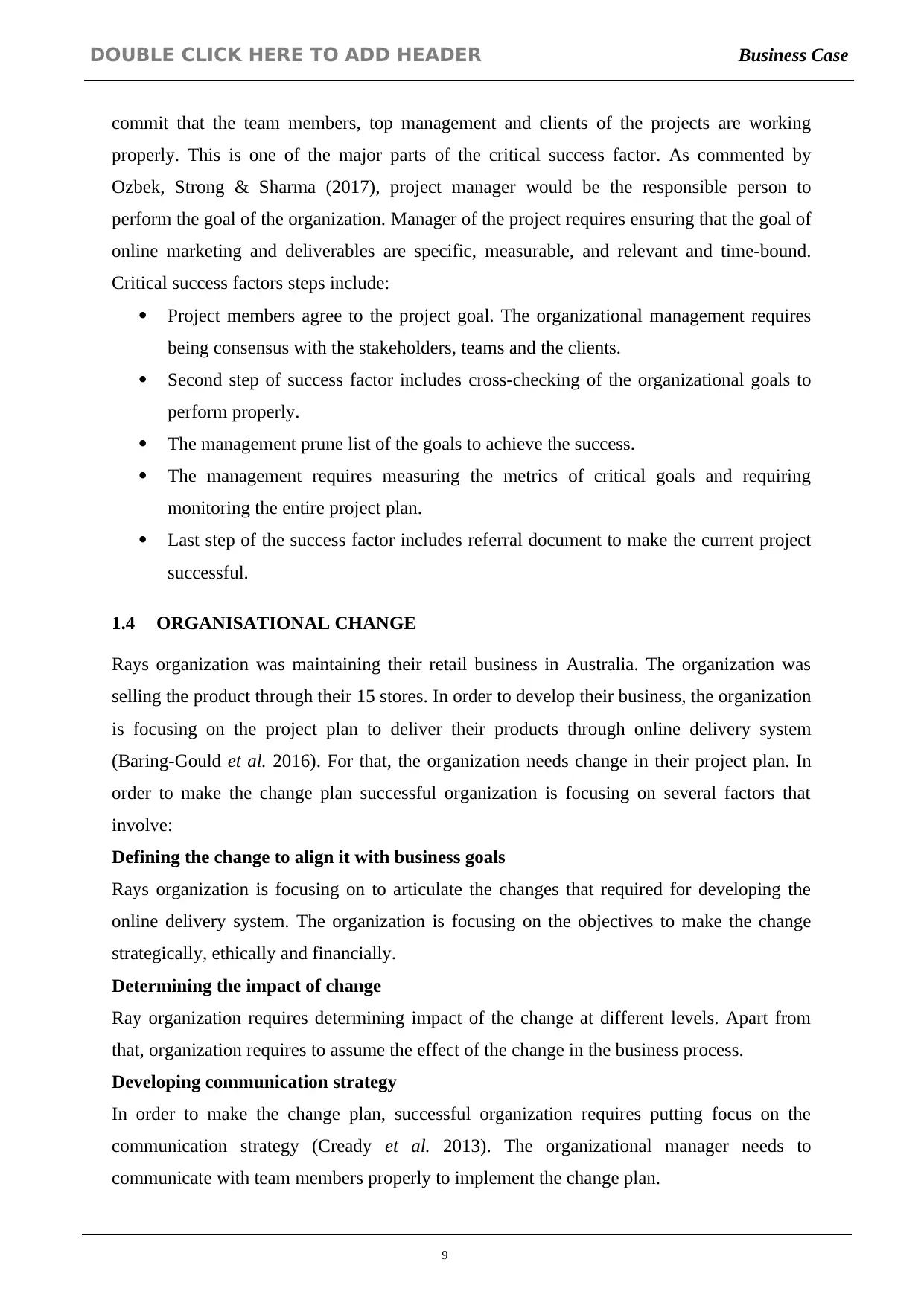
DOUBLE CLICK HERE TO ADD HEADER Business Case
commit that the team members, top management and clients of the projects are working
properly. This is one of the major parts of the critical success factor. As commented by
Ozbek, Strong & Sharma (2017), project manager would be the responsible person to
perform the goal of the organization. Manager of the project requires ensuring that the goal of
online marketing and deliverables are specific, measurable, and relevant and time-bound.
Critical success factors steps include:
Project members agree to the project goal. The organizational management requires
being consensus with the stakeholders, teams and the clients.
Second step of success factor includes cross-checking of the organizational goals to
perform properly.
The management prune list of the goals to achieve the success.
The management requires measuring the metrics of critical goals and requiring
monitoring the entire project plan.
Last step of the success factor includes referral document to make the current project
successful.
1.4 ORGANISATIONAL CHANGE
Rays organization was maintaining their retail business in Australia. The organization was
selling the product through their 15 stores. In order to develop their business, the organization
is focusing on the project plan to deliver their products through online delivery system
(Baring-Gould et al. 2016). For that, the organization needs change in their project plan. In
order to make the change plan successful organization is focusing on several factors that
involve:
Defining the change to align it with business goals
Rays organization is focusing on to articulate the changes that required for developing the
online delivery system. The organization is focusing on the objectives to make the change
strategically, ethically and financially.
Determining the impact of change
Ray organization requires determining impact of the change at different levels. Apart from
that, organization requires to assume the effect of the change in the business process.
Developing communication strategy
In order to make the change plan, successful organization requires putting focus on the
communication strategy (Cready et al. 2013). The organizational manager needs to
communicate with team members properly to implement the change plan.
9
commit that the team members, top management and clients of the projects are working
properly. This is one of the major parts of the critical success factor. As commented by
Ozbek, Strong & Sharma (2017), project manager would be the responsible person to
perform the goal of the organization. Manager of the project requires ensuring that the goal of
online marketing and deliverables are specific, measurable, and relevant and time-bound.
Critical success factors steps include:
Project members agree to the project goal. The organizational management requires
being consensus with the stakeholders, teams and the clients.
Second step of success factor includes cross-checking of the organizational goals to
perform properly.
The management prune list of the goals to achieve the success.
The management requires measuring the metrics of critical goals and requiring
monitoring the entire project plan.
Last step of the success factor includes referral document to make the current project
successful.
1.4 ORGANISATIONAL CHANGE
Rays organization was maintaining their retail business in Australia. The organization was
selling the product through their 15 stores. In order to develop their business, the organization
is focusing on the project plan to deliver their products through online delivery system
(Baring-Gould et al. 2016). For that, the organization needs change in their project plan. In
order to make the change plan successful organization is focusing on several factors that
involve:
Defining the change to align it with business goals
Rays organization is focusing on to articulate the changes that required for developing the
online delivery system. The organization is focusing on the objectives to make the change
strategically, ethically and financially.
Determining the impact of change
Ray organization requires determining impact of the change at different levels. Apart from
that, organization requires to assume the effect of the change in the business process.
Developing communication strategy
In order to make the change plan, successful organization requires putting focus on the
communication strategy (Cready et al. 2013). The organizational manager needs to
communicate with team members properly to implement the change plan.
9

DOUBLE CLICK HERE TO ADD HEADER Business Case
Providing proper training
In order to make the change plan, successful organization requires providing proper training
for the employees in order to operate new online delivery system work effectively.
Measuring the change process
The last part of the organizational change includes measuring the change impact on the retail
business process in order to ensure opportunities and proficiency (Aydin & Dilan, 2017). In
this part Rays, organization would try to measure change assist to achieve the business goals
and also watch over that the change is successful for the business or not.
10
Providing proper training
In order to make the change plan, successful organization requires providing proper training
for the employees in order to operate new online delivery system work effectively.
Measuring the change process
The last part of the organizational change includes measuring the change impact on the retail
business process in order to ensure opportunities and proficiency (Aydin & Dilan, 2017). In
this part Rays, organization would try to measure change assist to achieve the business goals
and also watch over that the change is successful for the business or not.
10
Secure Best Marks with AI Grader
Need help grading? Try our AI Grader for instant feedback on your assignments.
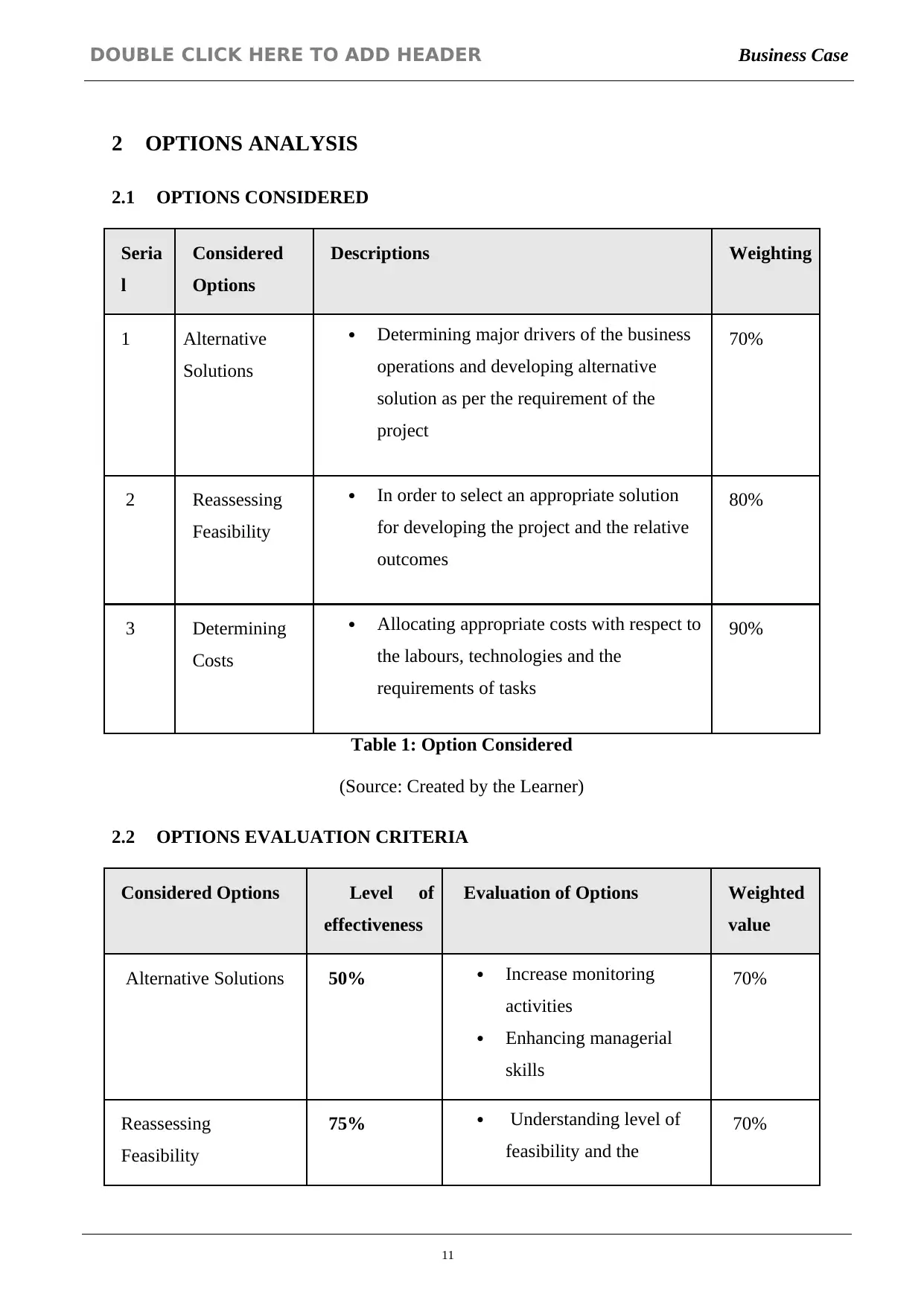
DOUBLE CLICK HERE TO ADD HEADER Business Case
2 OPTIONS ANALYSIS
2.1 OPTIONS CONSIDERED
Seria
l
Considered
Options
Descriptions Weighting
1 Alternative
Solutions
Determining major drivers of the business
operations and developing alternative
solution as per the requirement of the
project
70%
2 Reassessing
Feasibility
In order to select an appropriate solution
for developing the project and the relative
outcomes
80%
3 Determining
Costs
Allocating appropriate costs with respect to
the labours, technologies and the
requirements of tasks
90%
Table 1: Option Considered
(Source: Created by the Learner)
2.2 OPTIONS EVALUATION CRITERIA
Considered Options Level of
effectiveness
Evaluation of Options Weighted
value
Alternative Solutions 50% Increase monitoring
activities
Enhancing managerial
skills
70%
Reassessing
Feasibility
75% Understanding level of
feasibility and the
70%
11
2 OPTIONS ANALYSIS
2.1 OPTIONS CONSIDERED
Seria
l
Considered
Options
Descriptions Weighting
1 Alternative
Solutions
Determining major drivers of the business
operations and developing alternative
solution as per the requirement of the
project
70%
2 Reassessing
Feasibility
In order to select an appropriate solution
for developing the project and the relative
outcomes
80%
3 Determining
Costs
Allocating appropriate costs with respect to
the labours, technologies and the
requirements of tasks
90%
Table 1: Option Considered
(Source: Created by the Learner)
2.2 OPTIONS EVALUATION CRITERIA
Considered Options Level of
effectiveness
Evaluation of Options Weighted
value
Alternative Solutions 50% Increase monitoring
activities
Enhancing managerial
skills
70%
Reassessing
Feasibility
75% Understanding level of
feasibility and the
70%
11
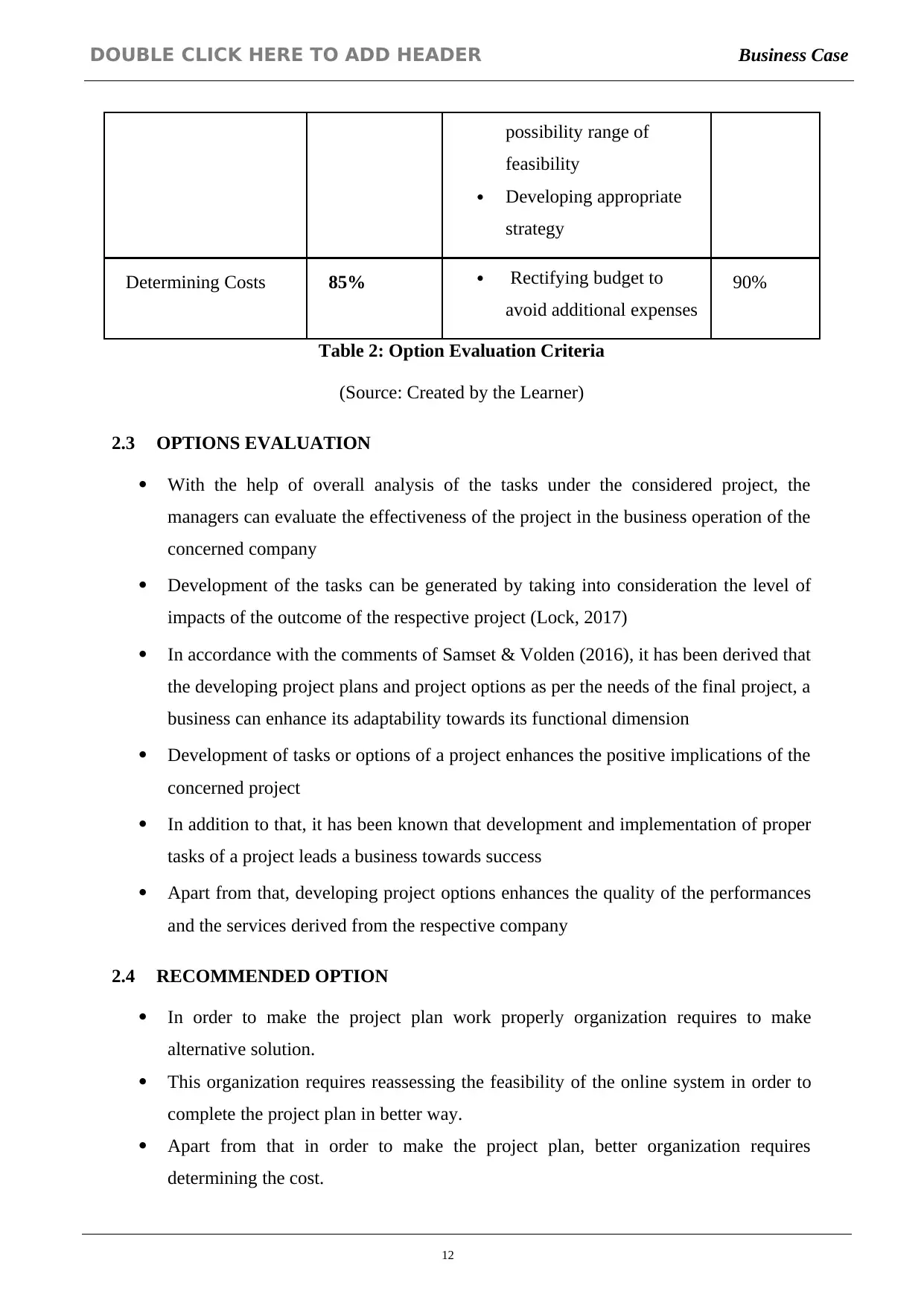
DOUBLE CLICK HERE TO ADD HEADER Business Case
possibility range of
feasibility
Developing appropriate
strategy
Determining Costs 85% Rectifying budget to
avoid additional expenses
90%
Table 2: Option Evaluation Criteria
(Source: Created by the Learner)
2.3 OPTIONS EVALUATION
With the help of overall analysis of the tasks under the considered project, the
managers can evaluate the effectiveness of the project in the business operation of the
concerned company
Development of the tasks can be generated by taking into consideration the level of
impacts of the outcome of the respective project (Lock, 2017)
In accordance with the comments of Samset & Volden (2016), it has been derived that
the developing project plans and project options as per the needs of the final project, a
business can enhance its adaptability towards its functional dimension
Development of tasks or options of a project enhances the positive implications of the
concerned project
In addition to that, it has been known that development and implementation of proper
tasks of a project leads a business towards success
Apart from that, developing project options enhances the quality of the performances
and the services derived from the respective company
2.4 RECOMMENDED OPTION
In order to make the project plan work properly organization requires to make
alternative solution.
This organization requires reassessing the feasibility of the online system in order to
complete the project plan in better way.
Apart from that in order to make the project plan, better organization requires
determining the cost.
12
possibility range of
feasibility
Developing appropriate
strategy
Determining Costs 85% Rectifying budget to
avoid additional expenses
90%
Table 2: Option Evaluation Criteria
(Source: Created by the Learner)
2.3 OPTIONS EVALUATION
With the help of overall analysis of the tasks under the considered project, the
managers can evaluate the effectiveness of the project in the business operation of the
concerned company
Development of the tasks can be generated by taking into consideration the level of
impacts of the outcome of the respective project (Lock, 2017)
In accordance with the comments of Samset & Volden (2016), it has been derived that
the developing project plans and project options as per the needs of the final project, a
business can enhance its adaptability towards its functional dimension
Development of tasks or options of a project enhances the positive implications of the
concerned project
In addition to that, it has been known that development and implementation of proper
tasks of a project leads a business towards success
Apart from that, developing project options enhances the quality of the performances
and the services derived from the respective company
2.4 RECOMMENDED OPTION
In order to make the project plan work properly organization requires to make
alternative solution.
This organization requires reassessing the feasibility of the online system in order to
complete the project plan in better way.
Apart from that in order to make the project plan, better organization requires
determining the cost.
12

DOUBLE CLICK HERE TO ADD HEADER Business Case
13
13
Paraphrase This Document
Need a fresh take? Get an instant paraphrase of this document with our AI Paraphraser
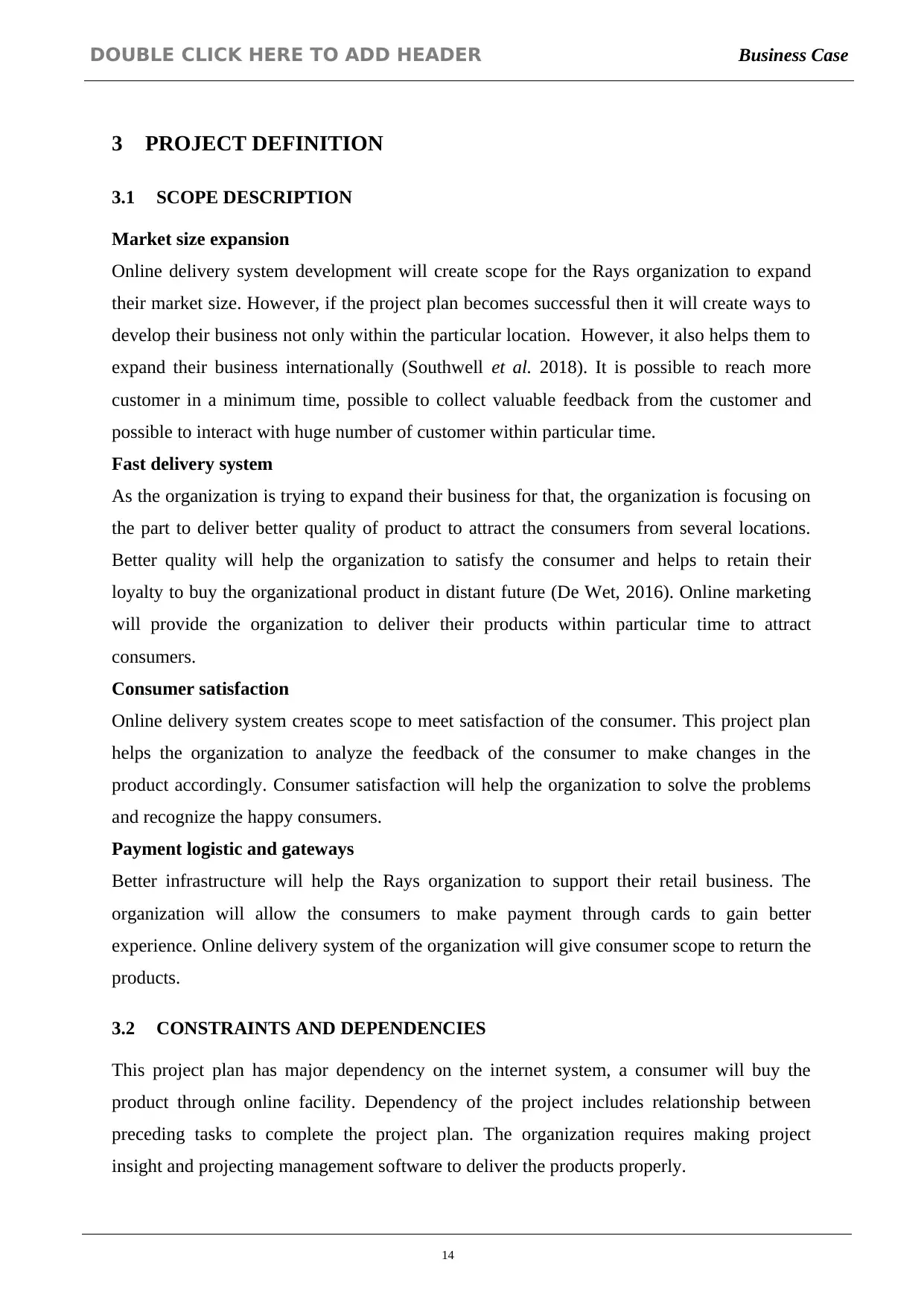
DOUBLE CLICK HERE TO ADD HEADER Business Case
3 PROJECT DEFINITION
3.1 SCOPE DESCRIPTION
Market size expansion
Online delivery system development will create scope for the Rays organization to expand
their market size. However, if the project plan becomes successful then it will create ways to
develop their business not only within the particular location. However, it also helps them to
expand their business internationally (Southwell et al. 2018). It is possible to reach more
customer in a minimum time, possible to collect valuable feedback from the customer and
possible to interact with huge number of customer within particular time.
Fast delivery system
As the organization is trying to expand their business for that, the organization is focusing on
the part to deliver better quality of product to attract the consumers from several locations.
Better quality will help the organization to satisfy the consumer and helps to retain their
loyalty to buy the organizational product in distant future (De Wet, 2016). Online marketing
will provide the organization to deliver their products within particular time to attract
consumers.
Consumer satisfaction
Online delivery system creates scope to meet satisfaction of the consumer. This project plan
helps the organization to analyze the feedback of the consumer to make changes in the
product accordingly. Consumer satisfaction will help the organization to solve the problems
and recognize the happy consumers.
Payment logistic and gateways
Better infrastructure will help the Rays organization to support their retail business. The
organization will allow the consumers to make payment through cards to gain better
experience. Online delivery system of the organization will give consumer scope to return the
products.
3.2 CONSTRAINTS AND DEPENDENCIES
This project plan has major dependency on the internet system, a consumer will buy the
product through online facility. Dependency of the project includes relationship between
preceding tasks to complete the project plan. The organization requires making project
insight and projecting management software to deliver the products properly.
14
3 PROJECT DEFINITION
3.1 SCOPE DESCRIPTION
Market size expansion
Online delivery system development will create scope for the Rays organization to expand
their market size. However, if the project plan becomes successful then it will create ways to
develop their business not only within the particular location. However, it also helps them to
expand their business internationally (Southwell et al. 2018). It is possible to reach more
customer in a minimum time, possible to collect valuable feedback from the customer and
possible to interact with huge number of customer within particular time.
Fast delivery system
As the organization is trying to expand their business for that, the organization is focusing on
the part to deliver better quality of product to attract the consumers from several locations.
Better quality will help the organization to satisfy the consumer and helps to retain their
loyalty to buy the organizational product in distant future (De Wet, 2016). Online marketing
will provide the organization to deliver their products within particular time to attract
consumers.
Consumer satisfaction
Online delivery system creates scope to meet satisfaction of the consumer. This project plan
helps the organization to analyze the feedback of the consumer to make changes in the
product accordingly. Consumer satisfaction will help the organization to solve the problems
and recognize the happy consumers.
Payment logistic and gateways
Better infrastructure will help the Rays organization to support their retail business. The
organization will allow the consumers to make payment through cards to gain better
experience. Online delivery system of the organization will give consumer scope to return the
products.
3.2 CONSTRAINTS AND DEPENDENCIES
This project plan has major dependency on the internet system, a consumer will buy the
product through online facility. Dependency of the project includes relationship between
preceding tasks to complete the project plan. The organization requires making project
insight and projecting management software to deliver the products properly.
14
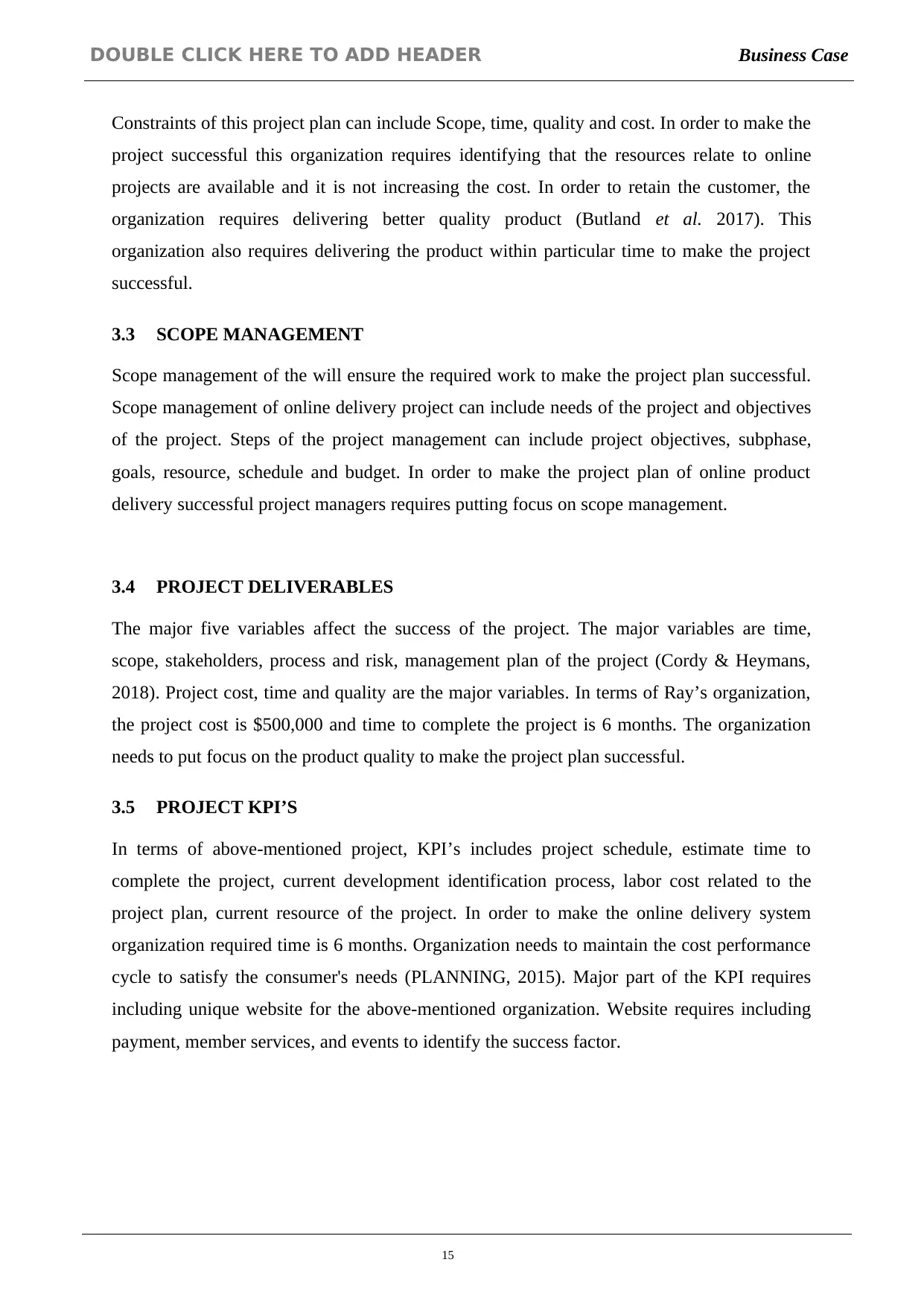
DOUBLE CLICK HERE TO ADD HEADER Business Case
Constraints of this project plan can include Scope, time, quality and cost. In order to make the
project successful this organization requires identifying that the resources relate to online
projects are available and it is not increasing the cost. In order to retain the customer, the
organization requires delivering better quality product (Butland et al. 2017). This
organization also requires delivering the product within particular time to make the project
successful.
3.3 SCOPE MANAGEMENT
Scope management of the will ensure the required work to make the project plan successful.
Scope management of online delivery project can include needs of the project and objectives
of the project. Steps of the project management can include project objectives, subphase,
goals, resource, schedule and budget. In order to make the project plan of online product
delivery successful project managers requires putting focus on scope management.
3.4 PROJECT DELIVERABLES
The major five variables affect the success of the project. The major variables are time,
scope, stakeholders, process and risk, management plan of the project (Cordy & Heymans,
2018). Project cost, time and quality are the major variables. In terms of Ray’s organization,
the project cost is $500,000 and time to complete the project is 6 months. The organization
needs to put focus on the product quality to make the project plan successful.
3.5 PROJECT KPI’S
In terms of above-mentioned project, KPI’s includes project schedule, estimate time to
complete the project, current development identification process, labor cost related to the
project plan, current resource of the project. In order to make the online delivery system
organization required time is 6 months. Organization needs to maintain the cost performance
cycle to satisfy the consumer's needs (PLANNING, 2015). Major part of the KPI requires
including unique website for the above-mentioned organization. Website requires including
payment, member services, and events to identify the success factor.
15
Constraints of this project plan can include Scope, time, quality and cost. In order to make the
project successful this organization requires identifying that the resources relate to online
projects are available and it is not increasing the cost. In order to retain the customer, the
organization requires delivering better quality product (Butland et al. 2017). This
organization also requires delivering the product within particular time to make the project
successful.
3.3 SCOPE MANAGEMENT
Scope management of the will ensure the required work to make the project plan successful.
Scope management of online delivery project can include needs of the project and objectives
of the project. Steps of the project management can include project objectives, subphase,
goals, resource, schedule and budget. In order to make the project plan of online product
delivery successful project managers requires putting focus on scope management.
3.4 PROJECT DELIVERABLES
The major five variables affect the success of the project. The major variables are time,
scope, stakeholders, process and risk, management plan of the project (Cordy & Heymans,
2018). Project cost, time and quality are the major variables. In terms of Ray’s organization,
the project cost is $500,000 and time to complete the project is 6 months. The organization
needs to put focus on the product quality to make the project plan successful.
3.5 PROJECT KPI’S
In terms of above-mentioned project, KPI’s includes project schedule, estimate time to
complete the project, current development identification process, labor cost related to the
project plan, current resource of the project. In order to make the online delivery system
organization required time is 6 months. Organization needs to maintain the cost performance
cycle to satisfy the consumer's needs (PLANNING, 2015). Major part of the KPI requires
including unique website for the above-mentioned organization. Website requires including
payment, member services, and events to identify the success factor.
15

DOUBLE CLICK HERE TO ADD HEADER Business Case
4 PROJECT APPROACH
4.1 PROJECT MANAGEMENT STRATEGY
4.1.1 PROJECT STRUCTURE
Project structures play a vital role in executing any strategies and successfully accomplish the
task. Project resources and roles need to identify for successful planning, resources and
estimating process. According to the idea of Kellenbrink and Helber (2015), Project structure
needs to prepare before embarking project so that all tasks will accomplish effectively. Some
basic rules that need to consider to structure teams are as follow:
● People working together and help each other to accomplish collective goal.
● Putting experience people in team creates collaboration, sharing and knowledge.
● Interaction between member to enhance feasibility
● Groups need to be divided according to people capabilities and potential
4.1.2 PROJECT GOVERNANCE FRAMEWORK
Project governance is an important aspect of a project to perform task in a sequence manner.
Information system prioritization group that look into strategies direction of project. With the
help of project governance framework, it is easy to handle problems in a well legal manner
(García et al. 2015).
● Its advice on the implementation and strategies direction of the project
● Project governance ensures that delivery and quality of the project included in the
project scope
● To recommend and consider strategies for development and continuation of the
project
● It monitors the performance growth of project managers.
● Project governance approves all functional plans as well as authorized escalated
deviation.
4.1.3 PROJECT REPORTING STRUCTURE
The project reporting structure represents the formal record related to entire processes of the
project that has been mentioned in the project schedule of the respective company.
16
4 PROJECT APPROACH
4.1 PROJECT MANAGEMENT STRATEGY
4.1.1 PROJECT STRUCTURE
Project structures play a vital role in executing any strategies and successfully accomplish the
task. Project resources and roles need to identify for successful planning, resources and
estimating process. According to the idea of Kellenbrink and Helber (2015), Project structure
needs to prepare before embarking project so that all tasks will accomplish effectively. Some
basic rules that need to consider to structure teams are as follow:
● People working together and help each other to accomplish collective goal.
● Putting experience people in team creates collaboration, sharing and knowledge.
● Interaction between member to enhance feasibility
● Groups need to be divided according to people capabilities and potential
4.1.2 PROJECT GOVERNANCE FRAMEWORK
Project governance is an important aspect of a project to perform task in a sequence manner.
Information system prioritization group that look into strategies direction of project. With the
help of project governance framework, it is easy to handle problems in a well legal manner
(García et al. 2015).
● Its advice on the implementation and strategies direction of the project
● Project governance ensures that delivery and quality of the project included in the
project scope
● To recommend and consider strategies for development and continuation of the
project
● It monitors the performance growth of project managers.
● Project governance approves all functional plans as well as authorized escalated
deviation.
4.1.3 PROJECT REPORTING STRUCTURE
The project reporting structure represents the formal record related to entire processes of the
project that has been mentioned in the project schedule of the respective company.
16
Secure Best Marks with AI Grader
Need help grading? Try our AI Grader for instant feedback on your assignments.
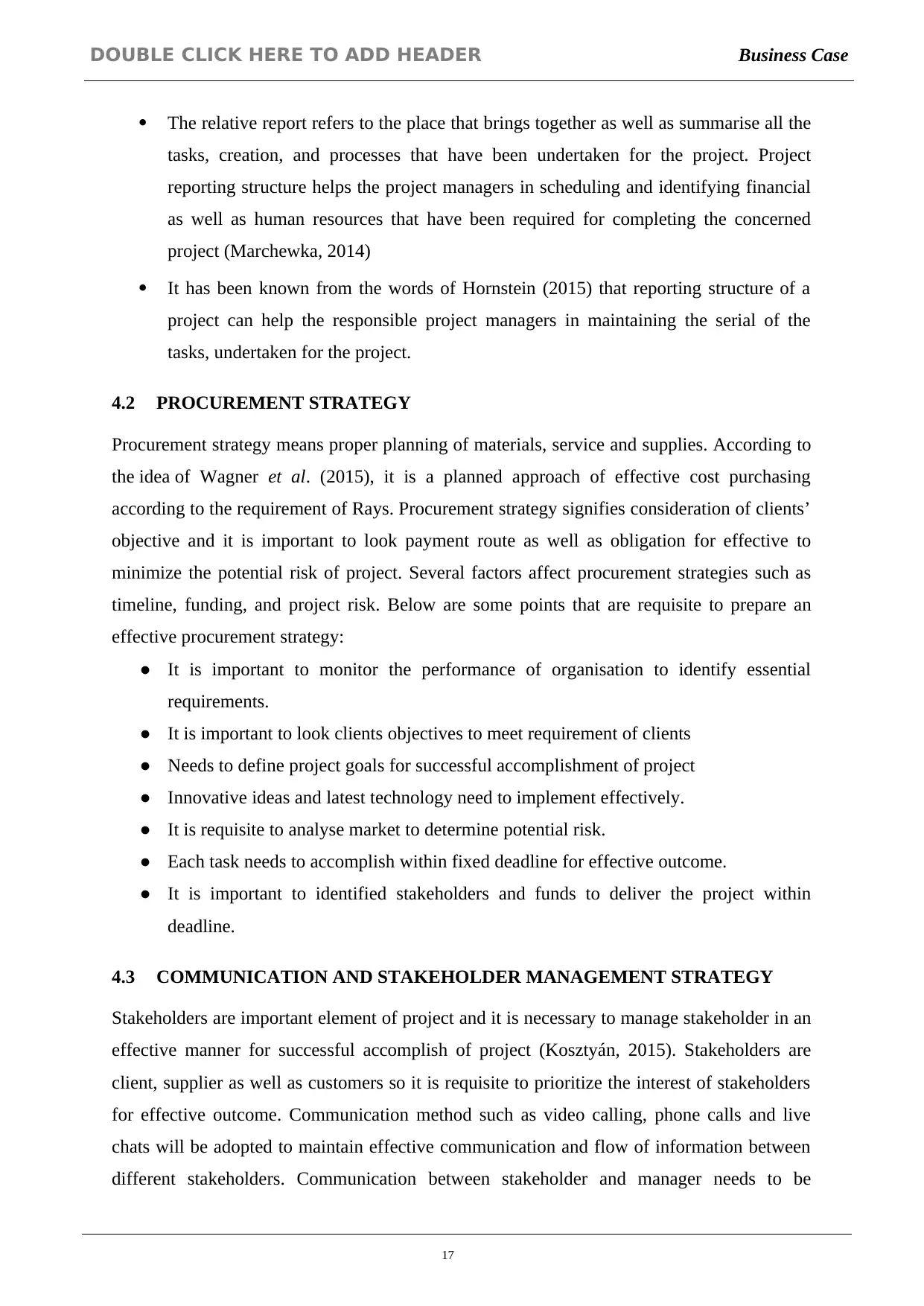
DOUBLE CLICK HERE TO ADD HEADER Business Case
The relative report refers to the place that brings together as well as summarise all the
tasks, creation, and processes that have been undertaken for the project. Project
reporting structure helps the project managers in scheduling and identifying financial
as well as human resources that have been required for completing the concerned
project (Marchewka, 2014)
It has been known from the words of Hornstein (2015) that reporting structure of a
project can help the responsible project managers in maintaining the serial of the
tasks, undertaken for the project.
4.2 PROCUREMENT STRATEGY
Procurement strategy means proper planning of materials, service and supplies. According to
the idea of Wagner et al. (2015), it is a planned approach of effective cost purchasing
according to the requirement of Rays. Procurement strategy signifies consideration of clients’
objective and it is important to look payment route as well as obligation for effective to
minimize the potential risk of project. Several factors affect procurement strategies such as
timeline, funding, and project risk. Below are some points that are requisite to prepare an
effective procurement strategy:
● It is important to monitor the performance of organisation to identify essential
requirements.
● It is important to look clients objectives to meet requirement of clients
● Needs to define project goals for successful accomplishment of project
● Innovative ideas and latest technology need to implement effectively.
● It is requisite to analyse market to determine potential risk.
● Each task needs to accomplish within fixed deadline for effective outcome.
● It is important to identified stakeholders and funds to deliver the project within
deadline.
4.3 COMMUNICATION AND STAKEHOLDER MANAGEMENT STRATEGY
Stakeholders are important element of project and it is necessary to manage stakeholder in an
effective manner for successful accomplish of project (Kosztyán, 2015). Stakeholders are
client, supplier as well as customers so it is requisite to prioritize the interest of stakeholders
for effective outcome. Communication method such as video calling, phone calls and live
chats will be adopted to maintain effective communication and flow of information between
different stakeholders. Communication between stakeholder and manager needs to be
17
The relative report refers to the place that brings together as well as summarise all the
tasks, creation, and processes that have been undertaken for the project. Project
reporting structure helps the project managers in scheduling and identifying financial
as well as human resources that have been required for completing the concerned
project (Marchewka, 2014)
It has been known from the words of Hornstein (2015) that reporting structure of a
project can help the responsible project managers in maintaining the serial of the
tasks, undertaken for the project.
4.2 PROCUREMENT STRATEGY
Procurement strategy means proper planning of materials, service and supplies. According to
the idea of Wagner et al. (2015), it is a planned approach of effective cost purchasing
according to the requirement of Rays. Procurement strategy signifies consideration of clients’
objective and it is important to look payment route as well as obligation for effective to
minimize the potential risk of project. Several factors affect procurement strategies such as
timeline, funding, and project risk. Below are some points that are requisite to prepare an
effective procurement strategy:
● It is important to monitor the performance of organisation to identify essential
requirements.
● It is important to look clients objectives to meet requirement of clients
● Needs to define project goals for successful accomplishment of project
● Innovative ideas and latest technology need to implement effectively.
● It is requisite to analyse market to determine potential risk.
● Each task needs to accomplish within fixed deadline for effective outcome.
● It is important to identified stakeholders and funds to deliver the project within
deadline.
4.3 COMMUNICATION AND STAKEHOLDER MANAGEMENT STRATEGY
Stakeholders are important element of project and it is necessary to manage stakeholder in an
effective manner for successful accomplish of project (Kosztyán, 2015). Stakeholders are
client, supplier as well as customers so it is requisite to prioritize the interest of stakeholders
for effective outcome. Communication method such as video calling, phone calls and live
chats will be adopted to maintain effective communication and flow of information between
different stakeholders. Communication between stakeholder and manager needs to be
17
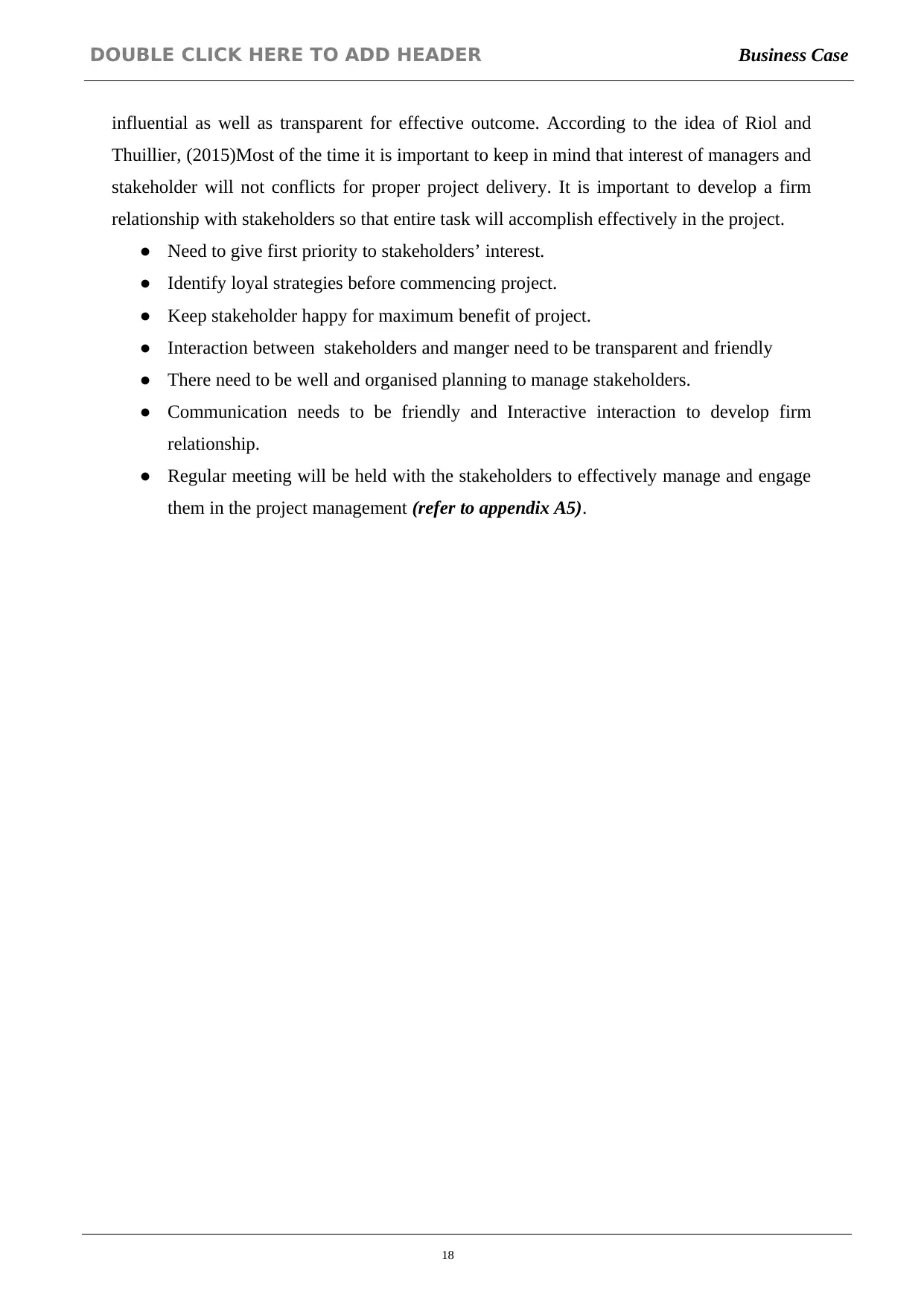
DOUBLE CLICK HERE TO ADD HEADER Business Case
influential as well as transparent for effective outcome. According to the idea of Riol and
Thuillier, (2015)Most of the time it is important to keep in mind that interest of managers and
stakeholder will not conflicts for proper project delivery. It is important to develop a firm
relationship with stakeholders so that entire task will accomplish effectively in the project.
● Need to give first priority to stakeholders’ interest.
● Identify loyal strategies before commencing project.
● Keep stakeholder happy for maximum benefit of project.
● Interaction between stakeholders and manger need to be transparent and friendly
● There need to be well and organised planning to manage stakeholders.
● Communication needs to be friendly and Interactive interaction to develop firm
relationship.
● Regular meeting will be held with the stakeholders to effectively manage and engage
them in the project management (refer to appendix A5).
18
influential as well as transparent for effective outcome. According to the idea of Riol and
Thuillier, (2015)Most of the time it is important to keep in mind that interest of managers and
stakeholder will not conflicts for proper project delivery. It is important to develop a firm
relationship with stakeholders so that entire task will accomplish effectively in the project.
● Need to give first priority to stakeholders’ interest.
● Identify loyal strategies before commencing project.
● Keep stakeholder happy for maximum benefit of project.
● Interaction between stakeholders and manger need to be transparent and friendly
● There need to be well and organised planning to manage stakeholders.
● Communication needs to be friendly and Interactive interaction to develop firm
relationship.
● Regular meeting will be held with the stakeholders to effectively manage and engage
them in the project management (refer to appendix A5).
18
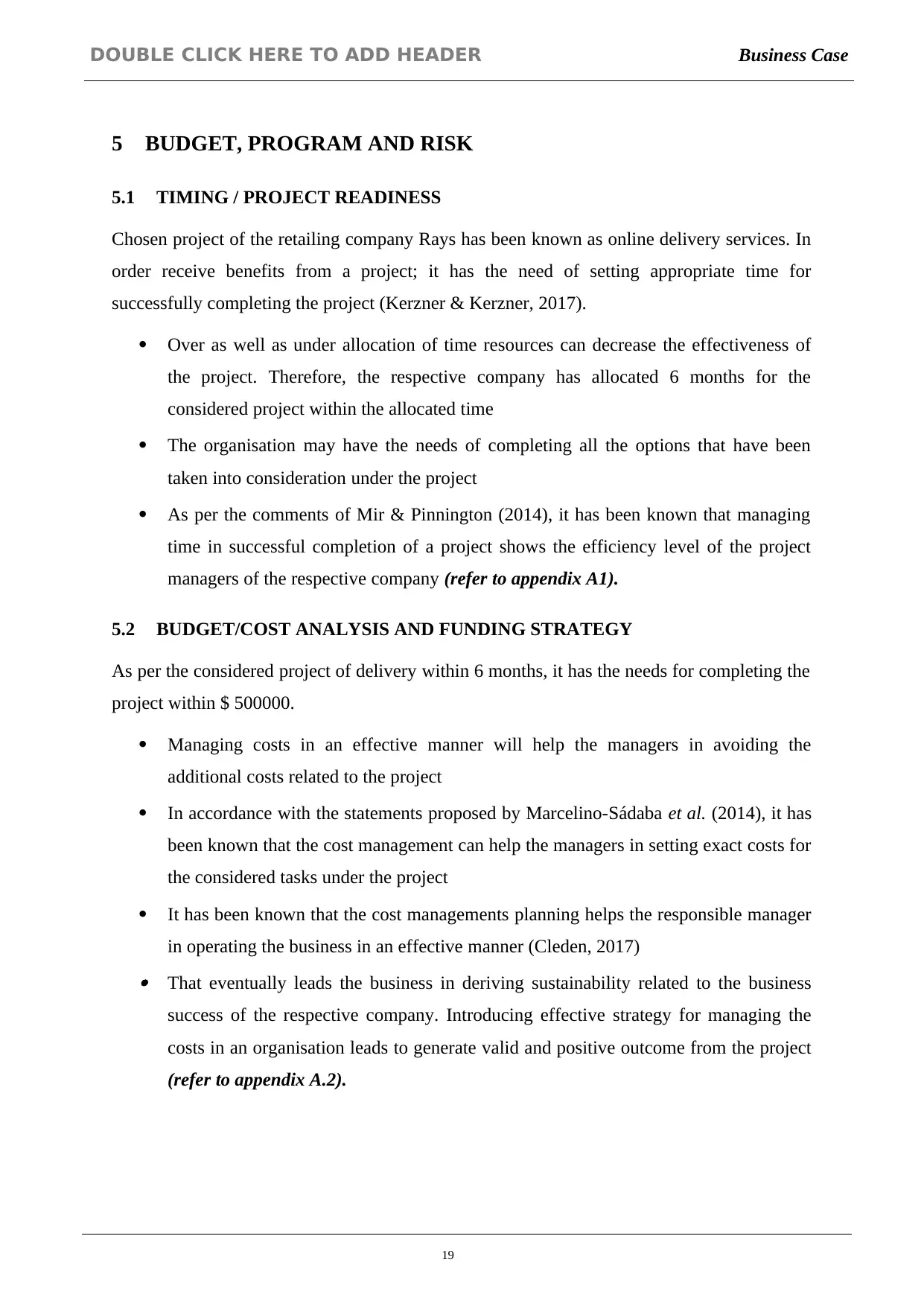
DOUBLE CLICK HERE TO ADD HEADER Business Case
5 BUDGET, PROGRAM AND RISK
5.1 TIMING / PROJECT READINESS
Chosen project of the retailing company Rays has been known as online delivery services. In
order receive benefits from a project; it has the need of setting appropriate time for
successfully completing the project (Kerzner & Kerzner, 2017).
Over as well as under allocation of time resources can decrease the effectiveness of
the project. Therefore, the respective company has allocated 6 months for the
considered project within the allocated time
The organisation may have the needs of completing all the options that have been
taken into consideration under the project
As per the comments of Mir & Pinnington (2014), it has been known that managing
time in successful completion of a project shows the efficiency level of the project
managers of the respective company (refer to appendix A1).
5.2 BUDGET/COST ANALYSIS AND FUNDING STRATEGY
As per the considered project of delivery within 6 months, it has the needs for completing the
project within $ 500000.
Managing costs in an effective manner will help the managers in avoiding the
additional costs related to the project
In accordance with the statements proposed by Marcelino-Sádaba et al. (2014), it has
been known that the cost management can help the managers in setting exact costs for
the considered tasks under the project
It has been known that the cost managements planning helps the responsible manager
in operating the business in an effective manner (Cleden, 2017) That eventually leads the business in deriving sustainability related to the business
success of the respective company. Introducing effective strategy for managing the
costs in an organisation leads to generate valid and positive outcome from the project
(refer to appendix A.2).
19
5 BUDGET, PROGRAM AND RISK
5.1 TIMING / PROJECT READINESS
Chosen project of the retailing company Rays has been known as online delivery services. In
order receive benefits from a project; it has the need of setting appropriate time for
successfully completing the project (Kerzner & Kerzner, 2017).
Over as well as under allocation of time resources can decrease the effectiveness of
the project. Therefore, the respective company has allocated 6 months for the
considered project within the allocated time
The organisation may have the needs of completing all the options that have been
taken into consideration under the project
As per the comments of Mir & Pinnington (2014), it has been known that managing
time in successful completion of a project shows the efficiency level of the project
managers of the respective company (refer to appendix A1).
5.2 BUDGET/COST ANALYSIS AND FUNDING STRATEGY
As per the considered project of delivery within 6 months, it has the needs for completing the
project within $ 500000.
Managing costs in an effective manner will help the managers in avoiding the
additional costs related to the project
In accordance with the statements proposed by Marcelino-Sádaba et al. (2014), it has
been known that the cost management can help the managers in setting exact costs for
the considered tasks under the project
It has been known that the cost managements planning helps the responsible manager
in operating the business in an effective manner (Cleden, 2017) That eventually leads the business in deriving sustainability related to the business
success of the respective company. Introducing effective strategy for managing the
costs in an organisation leads to generate valid and positive outcome from the project
(refer to appendix A.2).
19
Paraphrase This Document
Need a fresh take? Get an instant paraphrase of this document with our AI Paraphraser
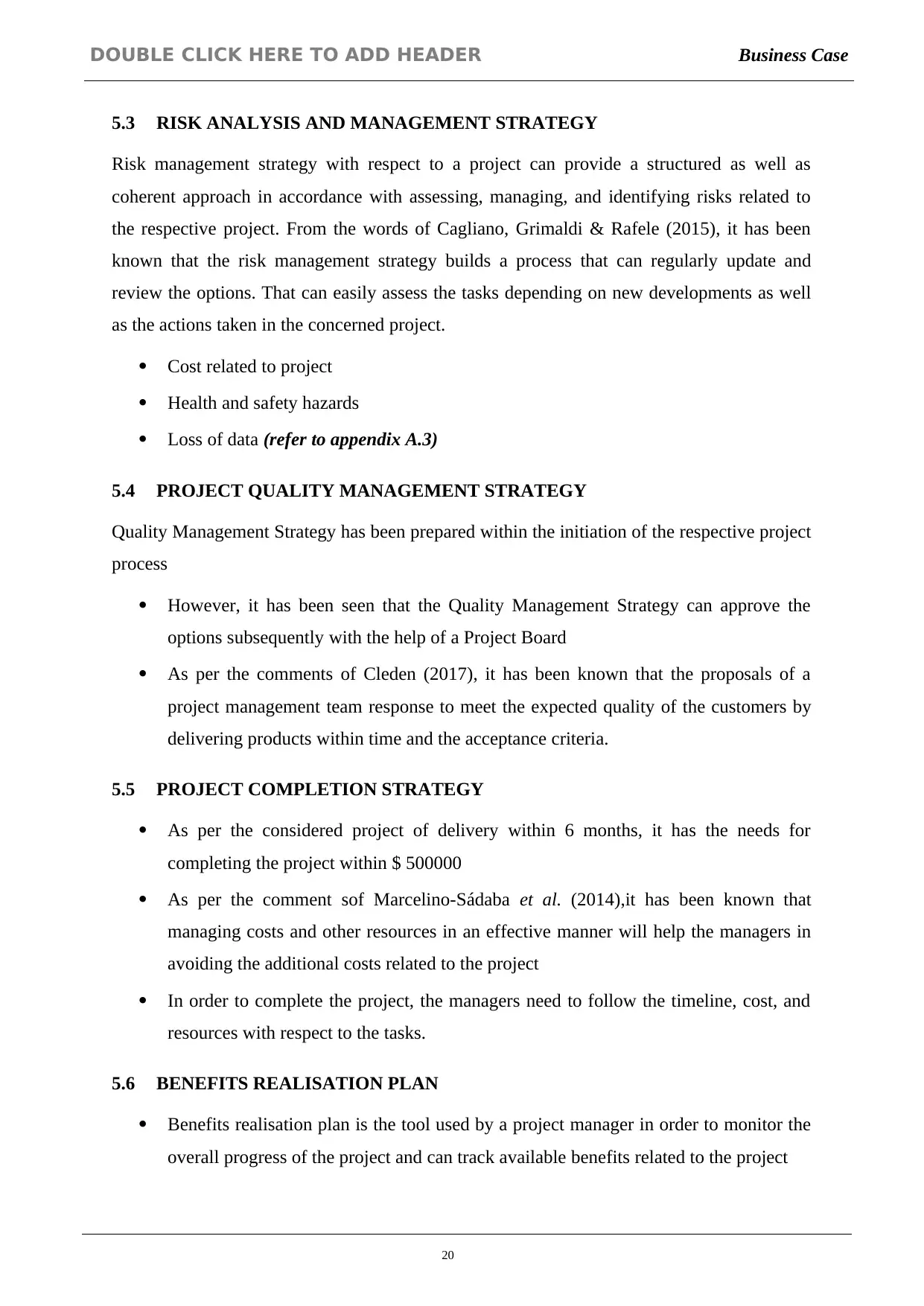
DOUBLE CLICK HERE TO ADD HEADER Business Case
5.3 RISK ANALYSIS AND MANAGEMENT STRATEGY
Risk management strategy with respect to a project can provide a structured as well as
coherent approach in accordance with assessing, managing, and identifying risks related to
the respective project. From the words of Cagliano, Grimaldi & Rafele (2015), it has been
known that the risk management strategy builds a process that can regularly update and
review the options. That can easily assess the tasks depending on new developments as well
as the actions taken in the concerned project.
Cost related to project
Health and safety hazards
Loss of data (refer to appendix A.3)
5.4 PROJECT QUALITY MANAGEMENT STRATEGY
Quality Management Strategy has been prepared within the initiation of the respective project
process
However, it has been seen that the Quality Management Strategy can approve the
options subsequently with the help of a Project Board
As per the comments of Cleden (2017), it has been known that the proposals of a
project management team response to meet the expected quality of the customers by
delivering products within time and the acceptance criteria.
5.5 PROJECT COMPLETION STRATEGY
As per the considered project of delivery within 6 months, it has the needs for
completing the project within $ 500000
As per the comment sof Marcelino-Sádaba et al. (2014),it has been known that
managing costs and other resources in an effective manner will help the managers in
avoiding the additional costs related to the project
In order to complete the project, the managers need to follow the timeline, cost, and
resources with respect to the tasks.
5.6 BENEFITS REALISATION PLAN
Benefits realisation plan is the tool used by a project manager in order to monitor the
overall progress of the project and can track available benefits related to the project
20
5.3 RISK ANALYSIS AND MANAGEMENT STRATEGY
Risk management strategy with respect to a project can provide a structured as well as
coherent approach in accordance with assessing, managing, and identifying risks related to
the respective project. From the words of Cagliano, Grimaldi & Rafele (2015), it has been
known that the risk management strategy builds a process that can regularly update and
review the options. That can easily assess the tasks depending on new developments as well
as the actions taken in the concerned project.
Cost related to project
Health and safety hazards
Loss of data (refer to appendix A.3)
5.4 PROJECT QUALITY MANAGEMENT STRATEGY
Quality Management Strategy has been prepared within the initiation of the respective project
process
However, it has been seen that the Quality Management Strategy can approve the
options subsequently with the help of a Project Board
As per the comments of Cleden (2017), it has been known that the proposals of a
project management team response to meet the expected quality of the customers by
delivering products within time and the acceptance criteria.
5.5 PROJECT COMPLETION STRATEGY
As per the considered project of delivery within 6 months, it has the needs for
completing the project within $ 500000
As per the comment sof Marcelino-Sádaba et al. (2014),it has been known that
managing costs and other resources in an effective manner will help the managers in
avoiding the additional costs related to the project
In order to complete the project, the managers need to follow the timeline, cost, and
resources with respect to the tasks.
5.6 BENEFITS REALISATION PLAN
Benefits realisation plan is the tool used by a project manager in order to monitor the
overall progress of the project and can track available benefits related to the project
20
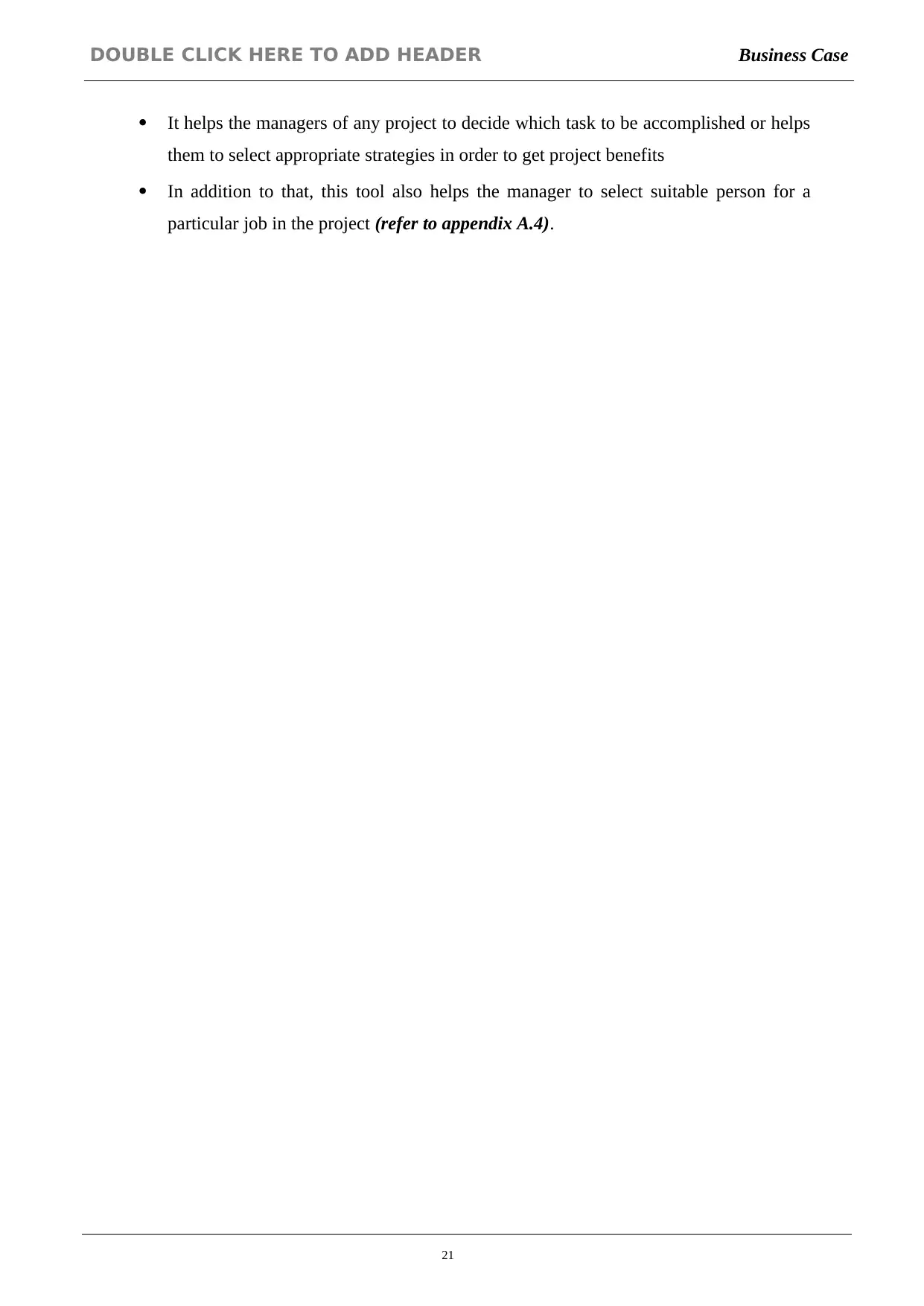
DOUBLE CLICK HERE TO ADD HEADER Business Case
It helps the managers of any project to decide which task to be accomplished or helps
them to select appropriate strategies in order to get project benefits
In addition to that, this tool also helps the manager to select suitable person for a
particular job in the project (refer to appendix A.4).
21
It helps the managers of any project to decide which task to be accomplished or helps
them to select appropriate strategies in order to get project benefits
In addition to that, this tool also helps the manager to select suitable person for a
particular job in the project (refer to appendix A.4).
21
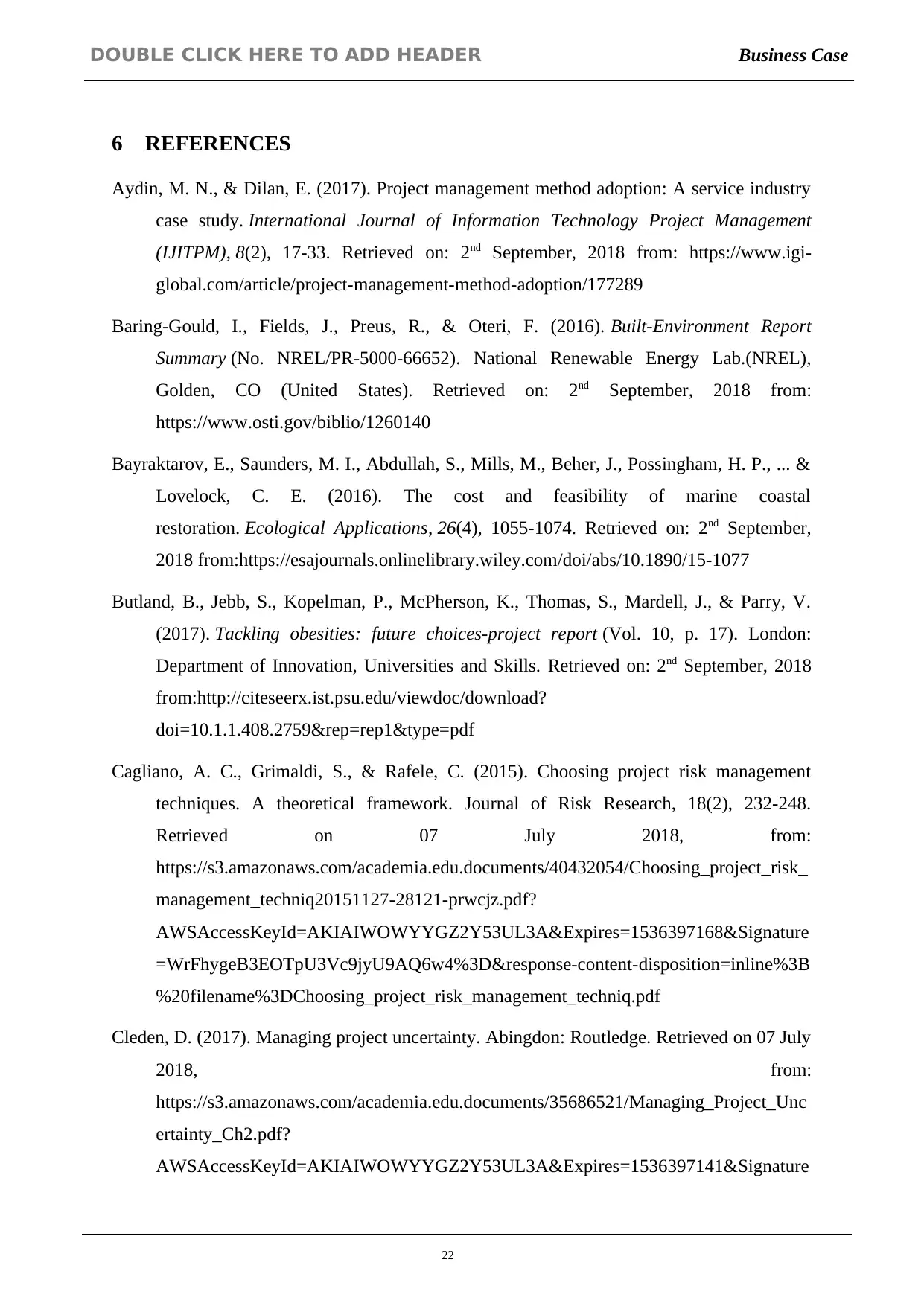
DOUBLE CLICK HERE TO ADD HEADER Business Case
6 REFERENCES
Aydin, M. N., & Dilan, E. (2017). Project management method adoption: A service industry
case study. International Journal of Information Technology Project Management
(IJITPM), 8(2), 17-33. Retrieved on: 2nd September, 2018 from: https://www.igi-
global.com/article/project-management-method-adoption/177289
Baring-Gould, I., Fields, J., Preus, R., & Oteri, F. (2016). Built-Environment Report
Summary (No. NREL/PR-5000-66652). National Renewable Energy Lab.(NREL),
Golden, CO (United States). Retrieved on: 2nd September, 2018 from:
https://www.osti.gov/biblio/1260140
Bayraktarov, E., Saunders, M. I., Abdullah, S., Mills, M., Beher, J., Possingham, H. P., ... &
Lovelock, C. E. (2016). The cost and feasibility of marine coastal
restoration. Ecological Applications, 26(4), 1055-1074. Retrieved on: 2nd September,
2018 from:https://esajournals.onlinelibrary.wiley.com/doi/abs/10.1890/15-1077
Butland, B., Jebb, S., Kopelman, P., McPherson, K., Thomas, S., Mardell, J., & Parry, V.
(2017). Tackling obesities: future choices-project report (Vol. 10, p. 17). London:
Department of Innovation, Universities and Skills. Retrieved on: 2nd September, 2018
from:http://citeseerx.ist.psu.edu/viewdoc/download?
doi=10.1.1.408.2759&rep=rep1&type=pdf
Cagliano, A. C., Grimaldi, S., & Rafele, C. (2015). Choosing project risk management
techniques. A theoretical framework. Journal of Risk Research, 18(2), 232-248.
Retrieved on 07 July 2018, from:
https://s3.amazonaws.com/academia.edu.documents/40432054/Choosing_project_risk_
management_techniq20151127-28121-prwcjz.pdf?
AWSAccessKeyId=AKIAIWOWYYGZ2Y53UL3A&Expires=1536397168&Signature
=WrFhygeB3EOTpU3Vc9jyU9AQ6w4%3D&response-content-disposition=inline%3B
%20filename%3DChoosing_project_risk_management_techniq.pdf
Cleden, D. (2017). Managing project uncertainty. Abingdon: Routledge. Retrieved on 07 July
2018, from:
https://s3.amazonaws.com/academia.edu.documents/35686521/Managing_Project_Unc
ertainty_Ch2.pdf?
AWSAccessKeyId=AKIAIWOWYYGZ2Y53UL3A&Expires=1536397141&Signature
22
6 REFERENCES
Aydin, M. N., & Dilan, E. (2017). Project management method adoption: A service industry
case study. International Journal of Information Technology Project Management
(IJITPM), 8(2), 17-33. Retrieved on: 2nd September, 2018 from: https://www.igi-
global.com/article/project-management-method-adoption/177289
Baring-Gould, I., Fields, J., Preus, R., & Oteri, F. (2016). Built-Environment Report
Summary (No. NREL/PR-5000-66652). National Renewable Energy Lab.(NREL),
Golden, CO (United States). Retrieved on: 2nd September, 2018 from:
https://www.osti.gov/biblio/1260140
Bayraktarov, E., Saunders, M. I., Abdullah, S., Mills, M., Beher, J., Possingham, H. P., ... &
Lovelock, C. E. (2016). The cost and feasibility of marine coastal
restoration. Ecological Applications, 26(4), 1055-1074. Retrieved on: 2nd September,
2018 from:https://esajournals.onlinelibrary.wiley.com/doi/abs/10.1890/15-1077
Butland, B., Jebb, S., Kopelman, P., McPherson, K., Thomas, S., Mardell, J., & Parry, V.
(2017). Tackling obesities: future choices-project report (Vol. 10, p. 17). London:
Department of Innovation, Universities and Skills. Retrieved on: 2nd September, 2018
from:http://citeseerx.ist.psu.edu/viewdoc/download?
doi=10.1.1.408.2759&rep=rep1&type=pdf
Cagliano, A. C., Grimaldi, S., & Rafele, C. (2015). Choosing project risk management
techniques. A theoretical framework. Journal of Risk Research, 18(2), 232-248.
Retrieved on 07 July 2018, from:
https://s3.amazonaws.com/academia.edu.documents/40432054/Choosing_project_risk_
management_techniq20151127-28121-prwcjz.pdf?
AWSAccessKeyId=AKIAIWOWYYGZ2Y53UL3A&Expires=1536397168&Signature
=WrFhygeB3EOTpU3Vc9jyU9AQ6w4%3D&response-content-disposition=inline%3B
%20filename%3DChoosing_project_risk_management_techniq.pdf
Cleden, D. (2017). Managing project uncertainty. Abingdon: Routledge. Retrieved on 07 July
2018, from:
https://s3.amazonaws.com/academia.edu.documents/35686521/Managing_Project_Unc
ertainty_Ch2.pdf?
AWSAccessKeyId=AKIAIWOWYYGZ2Y53UL3A&Expires=1536397141&Signature
22
Secure Best Marks with AI Grader
Need help grading? Try our AI Grader for instant feedback on your assignments.

DOUBLE CLICK HERE TO ADD HEADER Business Case
=wnmqrCfl%2FWeH1GircO7FFAvWYV0%3D&response-content-disposition=inline
%3B%20filename%3DManaging_Project_Uncertainty.pdf
Cordy, M., & Heymans, P. (2018, April). Engineering configurators for the retail industry:
experience report and challenges ahead. In Proceedings of the 33rd Annual ACM
Symposium on Applied Computing (pp. 2050-2057). ACM. Retrieved on: 2nd
September, 2018 from:https://dl.acm.org/citation.cfm?id=3167352
Cready, E., Lippert, J., Pihl, J., Weinstock, I., Symons, P., & Jungst, R. G. (2013). Final
report technical and economic feasibility of applying used EV batteries in stationary
applications. Sandia National Laboratory. Retrieved on: 2nd September, 2018
from:http://www.10xe.orwww.10xe.org/Content/Files/Technical%20and
%20feasible.pdf
De Wet, S. (2016). Developing a conceptual brand feasibility framework for a retail group in
South Africa (Doctoral dissertation). Retrieved on: 2nd September, 2018
from:http://wiredspace.wits.ac.za/handle/10539/20016
ECHETAMA, F. C., OBI, C., & JOEL, A. D. (2016). EFFECT OF FEASIBILITY STUDY
ON THE GROWTH OF SMEs IN IMO-STATE: A STUDY OF SELECTECTED
SMEs IN OWERRI ZONE. International Journal For Research In Business,
Management And Accounting (ISSN: 2455-6114), 2(2), 104-114. Retrieved on: 2nd
September, 2018 from:https://www.gnpublication.org/index.php/bma/article/view/473
García-Peñalvo, F. J., & Kearney, N. A. (2016, November). Networked youth research for
empowerment in digital society: the WYRED project. In Proceedings of the Fourth
International Conference on Technological Ecosystems for Enhancing
Multiculturality (pp. 3-9). ACM.
https://repositorio.grial.eu/bitstream/grial/738/1/WYRED_preprint.pdf
Harrison, F., & Lock, D. (2017). Advanced project management: a structured approach.
Routledge. Retrieved on: 2nd September, 2018 from: https://link.springer.com/nd
September, article/10.1007/s00330-016-4303-9
Hornstein, H. A. (2015). The integration of project management and organizational change
management is now a necessity. International Journal of Project Management, 33(2),
291-298. Retrieved on 07 July 2018, from:
https://fenix.tecnico.ulisboa.pt/downloadFile/845043405428940/13%20The
23
=wnmqrCfl%2FWeH1GircO7FFAvWYV0%3D&response-content-disposition=inline
%3B%20filename%3DManaging_Project_Uncertainty.pdf
Cordy, M., & Heymans, P. (2018, April). Engineering configurators for the retail industry:
experience report and challenges ahead. In Proceedings of the 33rd Annual ACM
Symposium on Applied Computing (pp. 2050-2057). ACM. Retrieved on: 2nd
September, 2018 from:https://dl.acm.org/citation.cfm?id=3167352
Cready, E., Lippert, J., Pihl, J., Weinstock, I., Symons, P., & Jungst, R. G. (2013). Final
report technical and economic feasibility of applying used EV batteries in stationary
applications. Sandia National Laboratory. Retrieved on: 2nd September, 2018
from:http://www.10xe.orwww.10xe.org/Content/Files/Technical%20and
%20feasible.pdf
De Wet, S. (2016). Developing a conceptual brand feasibility framework for a retail group in
South Africa (Doctoral dissertation). Retrieved on: 2nd September, 2018
from:http://wiredspace.wits.ac.za/handle/10539/20016
ECHETAMA, F. C., OBI, C., & JOEL, A. D. (2016). EFFECT OF FEASIBILITY STUDY
ON THE GROWTH OF SMEs IN IMO-STATE: A STUDY OF SELECTECTED
SMEs IN OWERRI ZONE. International Journal For Research In Business,
Management And Accounting (ISSN: 2455-6114), 2(2), 104-114. Retrieved on: 2nd
September, 2018 from:https://www.gnpublication.org/index.php/bma/article/view/473
García-Peñalvo, F. J., & Kearney, N. A. (2016, November). Networked youth research for
empowerment in digital society: the WYRED project. In Proceedings of the Fourth
International Conference on Technological Ecosystems for Enhancing
Multiculturality (pp. 3-9). ACM.
https://repositorio.grial.eu/bitstream/grial/738/1/WYRED_preprint.pdf
Harrison, F., & Lock, D. (2017). Advanced project management: a structured approach.
Routledge. Retrieved on: 2nd September, 2018 from: https://link.springer.com/nd
September, article/10.1007/s00330-016-4303-9
Hornstein, H. A. (2015). The integration of project management and organizational change
management is now a necessity. International Journal of Project Management, 33(2),
291-298. Retrieved on 07 July 2018, from:
https://fenix.tecnico.ulisboa.pt/downloadFile/845043405428940/13%20The
23
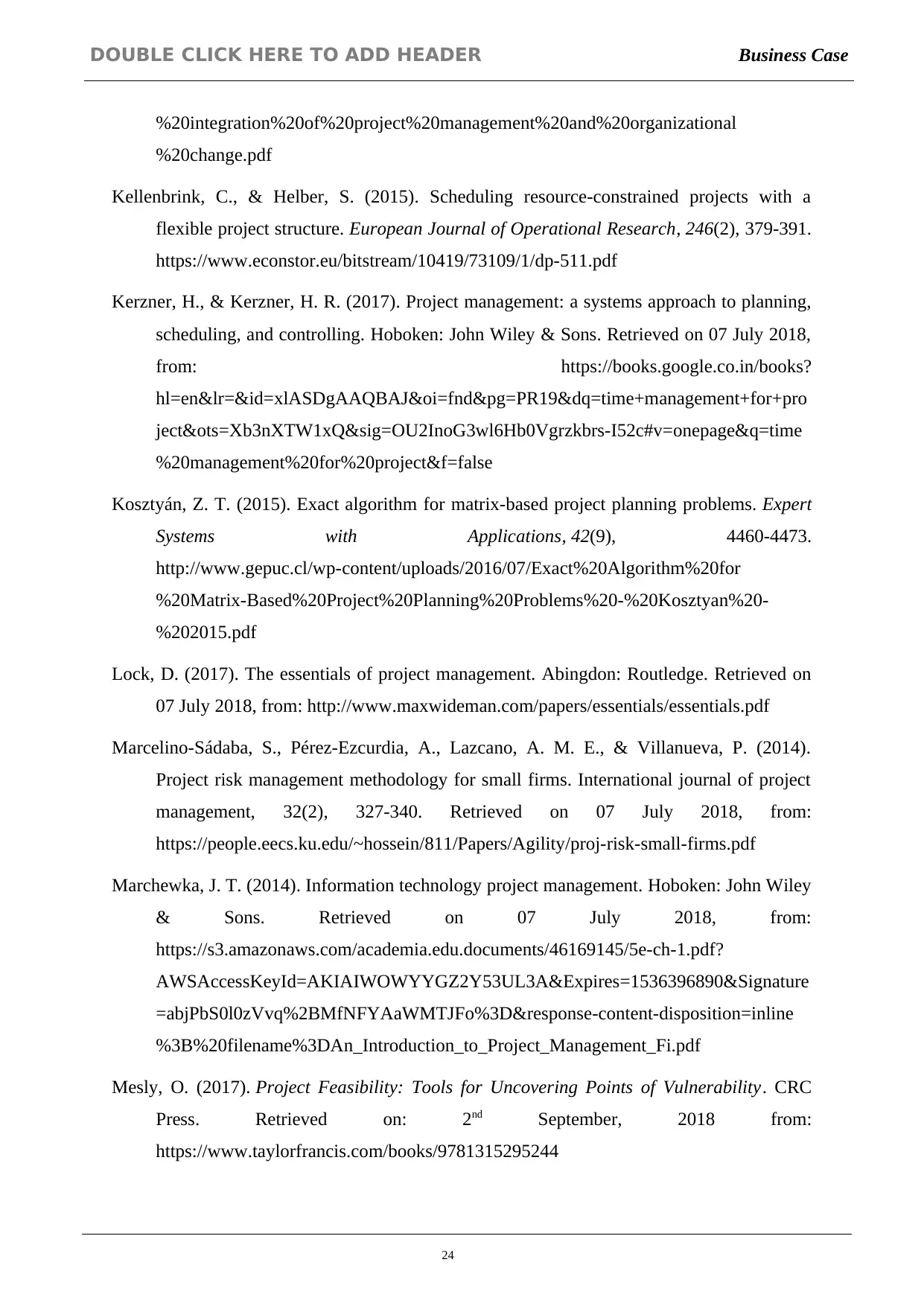
DOUBLE CLICK HERE TO ADD HEADER Business Case
%20integration%20of%20project%20management%20and%20organizational
%20change.pdf
Kellenbrink, C., & Helber, S. (2015). Scheduling resource-constrained projects with a
flexible project structure. European Journal of Operational Research, 246(2), 379-391.
https://www.econstor.eu/bitstream/10419/73109/1/dp-511.pdf
Kerzner, H., & Kerzner, H. R. (2017). Project management: a systems approach to planning,
scheduling, and controlling. Hoboken: John Wiley & Sons. Retrieved on 07 July 2018,
from: https://books.google.co.in/books?
hl=en&lr=&id=xlASDgAAQBAJ&oi=fnd&pg=PR19&dq=time+management+for+pro
ject&ots=Xb3nXTW1xQ&sig=OU2InoG3wl6Hb0Vgrzkbrs-I52c#v=onepage&q=time
%20management%20for%20project&f=false
Kosztyán, Z. T. (2015). Exact algorithm for matrix-based project planning problems. Expert
Systems with Applications, 42(9), 4460-4473.
http://www.gepuc.cl/wp-content/uploads/2016/07/Exact%20Algorithm%20for
%20Matrix-Based%20Project%20Planning%20Problems%20-%20Kosztyan%20-
%202015.pdf
Lock, D. (2017). The essentials of project management. Abingdon: Routledge. Retrieved on
07 July 2018, from: http://www.maxwideman.com/papers/essentials/essentials.pdf
Marcelino-Sádaba, S., Pérez-Ezcurdia, A., Lazcano, A. M. E., & Villanueva, P. (2014).
Project risk management methodology for small firms. International journal of project
management, 32(2), 327-340. Retrieved on 07 July 2018, from:
https://people.eecs.ku.edu/~hossein/811/Papers/Agility/proj-risk-small-firms.pdf
Marchewka, J. T. (2014). Information technology project management. Hoboken: John Wiley
& Sons. Retrieved on 07 July 2018, from:
https://s3.amazonaws.com/academia.edu.documents/46169145/5e-ch-1.pdf?
AWSAccessKeyId=AKIAIWOWYYGZ2Y53UL3A&Expires=1536396890&Signature
=abjPbS0l0zVvq%2BMfNFYAaWMTJFo%3D&response-content-disposition=inline
%3B%20filename%3DAn_Introduction_to_Project_Management_Fi.pdf
Mesly, O. (2017). Project Feasibility: Tools for Uncovering Points of Vulnerability. CRC
Press. Retrieved on: 2nd September, 2018 from:
https://www.taylorfrancis.com/books/9781315295244
24
%20integration%20of%20project%20management%20and%20organizational
%20change.pdf
Kellenbrink, C., & Helber, S. (2015). Scheduling resource-constrained projects with a
flexible project structure. European Journal of Operational Research, 246(2), 379-391.
https://www.econstor.eu/bitstream/10419/73109/1/dp-511.pdf
Kerzner, H., & Kerzner, H. R. (2017). Project management: a systems approach to planning,
scheduling, and controlling. Hoboken: John Wiley & Sons. Retrieved on 07 July 2018,
from: https://books.google.co.in/books?
hl=en&lr=&id=xlASDgAAQBAJ&oi=fnd&pg=PR19&dq=time+management+for+pro
ject&ots=Xb3nXTW1xQ&sig=OU2InoG3wl6Hb0Vgrzkbrs-I52c#v=onepage&q=time
%20management%20for%20project&f=false
Kosztyán, Z. T. (2015). Exact algorithm for matrix-based project planning problems. Expert
Systems with Applications, 42(9), 4460-4473.
http://www.gepuc.cl/wp-content/uploads/2016/07/Exact%20Algorithm%20for
%20Matrix-Based%20Project%20Planning%20Problems%20-%20Kosztyan%20-
%202015.pdf
Lock, D. (2017). The essentials of project management. Abingdon: Routledge. Retrieved on
07 July 2018, from: http://www.maxwideman.com/papers/essentials/essentials.pdf
Marcelino-Sádaba, S., Pérez-Ezcurdia, A., Lazcano, A. M. E., & Villanueva, P. (2014).
Project risk management methodology for small firms. International journal of project
management, 32(2), 327-340. Retrieved on 07 July 2018, from:
https://people.eecs.ku.edu/~hossein/811/Papers/Agility/proj-risk-small-firms.pdf
Marchewka, J. T. (2014). Information technology project management. Hoboken: John Wiley
& Sons. Retrieved on 07 July 2018, from:
https://s3.amazonaws.com/academia.edu.documents/46169145/5e-ch-1.pdf?
AWSAccessKeyId=AKIAIWOWYYGZ2Y53UL3A&Expires=1536396890&Signature
=abjPbS0l0zVvq%2BMfNFYAaWMTJFo%3D&response-content-disposition=inline
%3B%20filename%3DAn_Introduction_to_Project_Management_Fi.pdf
Mesly, O. (2017). Project Feasibility: Tools for Uncovering Points of Vulnerability. CRC
Press. Retrieved on: 2nd September, 2018 from:
https://www.taylorfrancis.com/books/9781315295244
24

DOUBLE CLICK HERE TO ADD HEADER Business Case
Mir, F. A., & Pinnington, A. H. (2014). Exploring the value of project management: linking
project management performance and project success. International journal of project
management, 32(2), 202-217. Retrieved on 07 July 2018, from:
https://s3.amazonaws.com/academia.edu.documents/49531710/Exploring_the_value_of
_project_management_Linking_Project_Management.pdf?
AWSAccessKeyId=AKIAIWOWYYGZ2Y53UL3A&Expires=1536396826&Signature
=1cS8A2px%2BNBETruiBUfbRjYZe6s%3D&response-content-disposition=inline
%3B%20filename%3DExploring_the_value_of_project_managemen.pdf
Ozbek, M. E., Strong, K. C., & Sharma, A. (2017). A Framework for Assessing Feasibility of
Transit-Oriented Development (TOD) Project Sites: Research Brief (No. MPC 17-330
(project 485)). Mountain Plains Consortium. Retrieved on: 2nd September, 2018
from:https://rosap.ntl.bts.gov/view/dot/32899
PLANNING, L. R. (2015). Community Development Agency. Website: http://199.233, 45.
Retrieved on: 2nd September, 2018 from:https://www.igi-global.com/article/project-
management-method-adoption/177289
Riol, H., & Thuillier, D. (2015). Project management for academic research projects:
balancing structure and flexibility. International Journal of Project Organisation and
Management, 7(3), 251-269.
https://www.researchgate.net/profile/Denis_Thuillier/publication/282210826_Project_
management_for_academic_research_projects_Balancing_structure_and_flexibility/
links/56abc8e008aeaa696f29fbba/Project-management-for-academic-research-projects-
Balancing-structure-and-flexibility.pdf
Samset, K., & Volden, G. H. (2016). Front-end definition of projects: Ten paradoxes and
some reflections regarding project management and project governance. International
Journal of Project Management, 34(2), 297-313. Retrieved on 07 July 2018, from:
https://www.sciencedirect.com/science/article/abs/pii/S0263786315000320
Southwell, G., Schrader, H., Miller, J., & Quateman, L. G. (2018). Using and Evaluating
Expert Work Products in Municipal Offerings: Risk Assessments. Municipal Finance
Journal, 38(4). Retrieved on: 2nd September, 2018
from:http://search.ebscohost.com/login.aspx?
direct=true&profile=ehost&scope=site&authtype=crawler&jrnl=01996134&AN=1308
25
Mir, F. A., & Pinnington, A. H. (2014). Exploring the value of project management: linking
project management performance and project success. International journal of project
management, 32(2), 202-217. Retrieved on 07 July 2018, from:
https://s3.amazonaws.com/academia.edu.documents/49531710/Exploring_the_value_of
_project_management_Linking_Project_Management.pdf?
AWSAccessKeyId=AKIAIWOWYYGZ2Y53UL3A&Expires=1536396826&Signature
=1cS8A2px%2BNBETruiBUfbRjYZe6s%3D&response-content-disposition=inline
%3B%20filename%3DExploring_the_value_of_project_managemen.pdf
Ozbek, M. E., Strong, K. C., & Sharma, A. (2017). A Framework for Assessing Feasibility of
Transit-Oriented Development (TOD) Project Sites: Research Brief (No. MPC 17-330
(project 485)). Mountain Plains Consortium. Retrieved on: 2nd September, 2018
from:https://rosap.ntl.bts.gov/view/dot/32899
PLANNING, L. R. (2015). Community Development Agency. Website: http://199.233, 45.
Retrieved on: 2nd September, 2018 from:https://www.igi-global.com/article/project-
management-method-adoption/177289
Riol, H., & Thuillier, D. (2015). Project management for academic research projects:
balancing structure and flexibility. International Journal of Project Organisation and
Management, 7(3), 251-269.
https://www.researchgate.net/profile/Denis_Thuillier/publication/282210826_Project_
management_for_academic_research_projects_Balancing_structure_and_flexibility/
links/56abc8e008aeaa696f29fbba/Project-management-for-academic-research-projects-
Balancing-structure-and-flexibility.pdf
Samset, K., & Volden, G. H. (2016). Front-end definition of projects: Ten paradoxes and
some reflections regarding project management and project governance. International
Journal of Project Management, 34(2), 297-313. Retrieved on 07 July 2018, from:
https://www.sciencedirect.com/science/article/abs/pii/S0263786315000320
Southwell, G., Schrader, H., Miller, J., & Quateman, L. G. (2018). Using and Evaluating
Expert Work Products in Municipal Offerings: Risk Assessments. Municipal Finance
Journal, 38(4). Retrieved on: 2nd September, 2018
from:http://search.ebscohost.com/login.aspx?
direct=true&profile=ehost&scope=site&authtype=crawler&jrnl=01996134&AN=1308
25
Paraphrase This Document
Need a fresh take? Get an instant paraphrase of this document with our AI Paraphraser
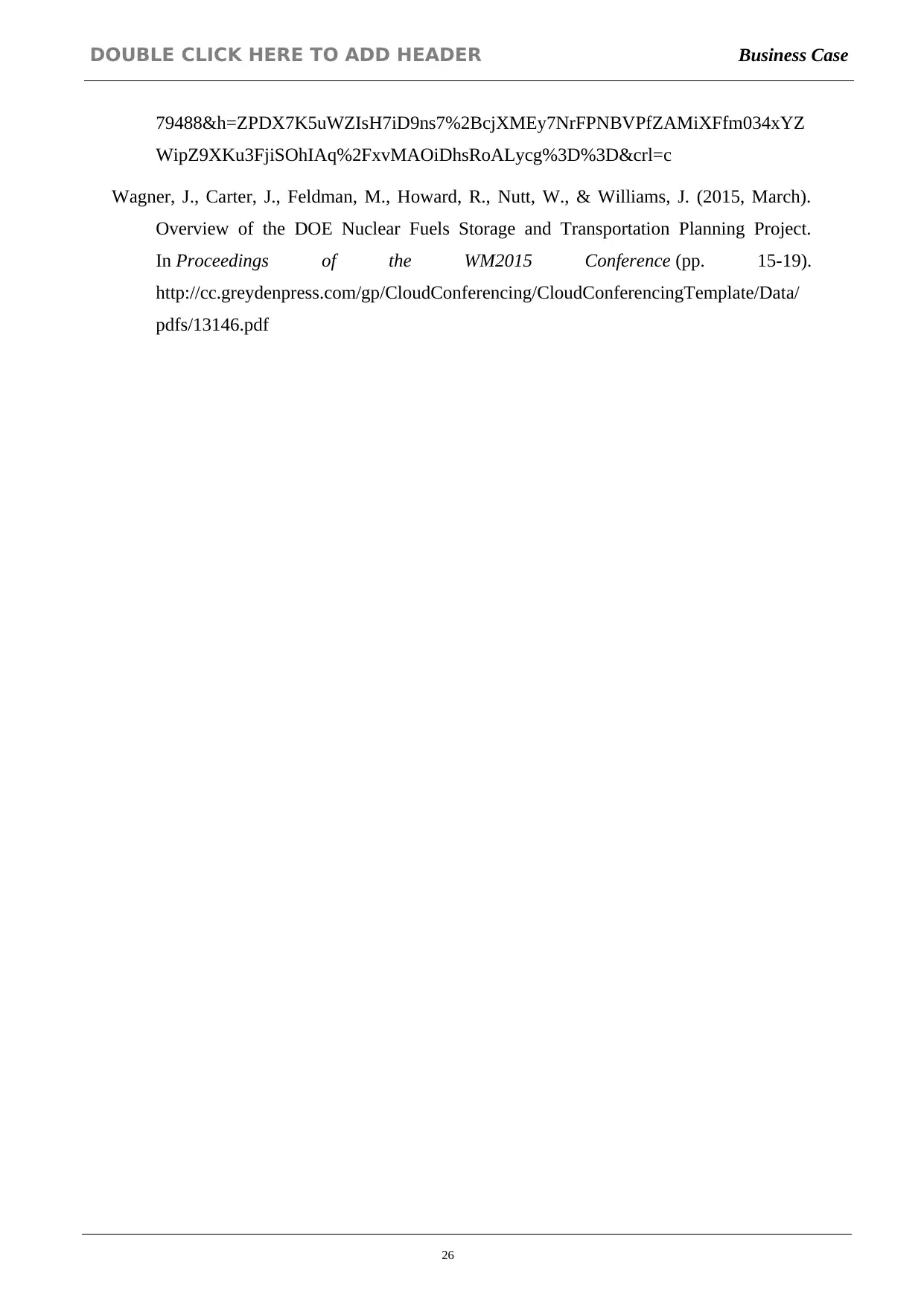
DOUBLE CLICK HERE TO ADD HEADER Business Case
79488&h=ZPDX7K5uWZIsH7iD9ns7%2BcjXMEy7NrFPNBVPfZAMiXFfm034xYZ
WipZ9XKu3FjiSOhIAq%2FxvMAOiDhsRoALycg%3D%3D&crl=c
Wagner, J., Carter, J., Feldman, M., Howard, R., Nutt, W., & Williams, J. (2015, March).
Overview of the DOE Nuclear Fuels Storage and Transportation Planning Project.
In Proceedings of the WM2015 Conference (pp. 15-19).
http://cc.greydenpress.com/gp/CloudConferencing/CloudConferencingTemplate/Data/
pdfs/13146.pdf
26
79488&h=ZPDX7K5uWZIsH7iD9ns7%2BcjXMEy7NrFPNBVPfZAMiXFfm034xYZ
WipZ9XKu3FjiSOhIAq%2FxvMAOiDhsRoALycg%3D%3D&crl=c
Wagner, J., Carter, J., Feldman, M., Howard, R., Nutt, W., & Williams, J. (2015, March).
Overview of the DOE Nuclear Fuels Storage and Transportation Planning Project.
In Proceedings of the WM2015 Conference (pp. 15-19).
http://cc.greydenpress.com/gp/CloudConferencing/CloudConferencingTemplate/Data/
pdfs/13146.pdf
26
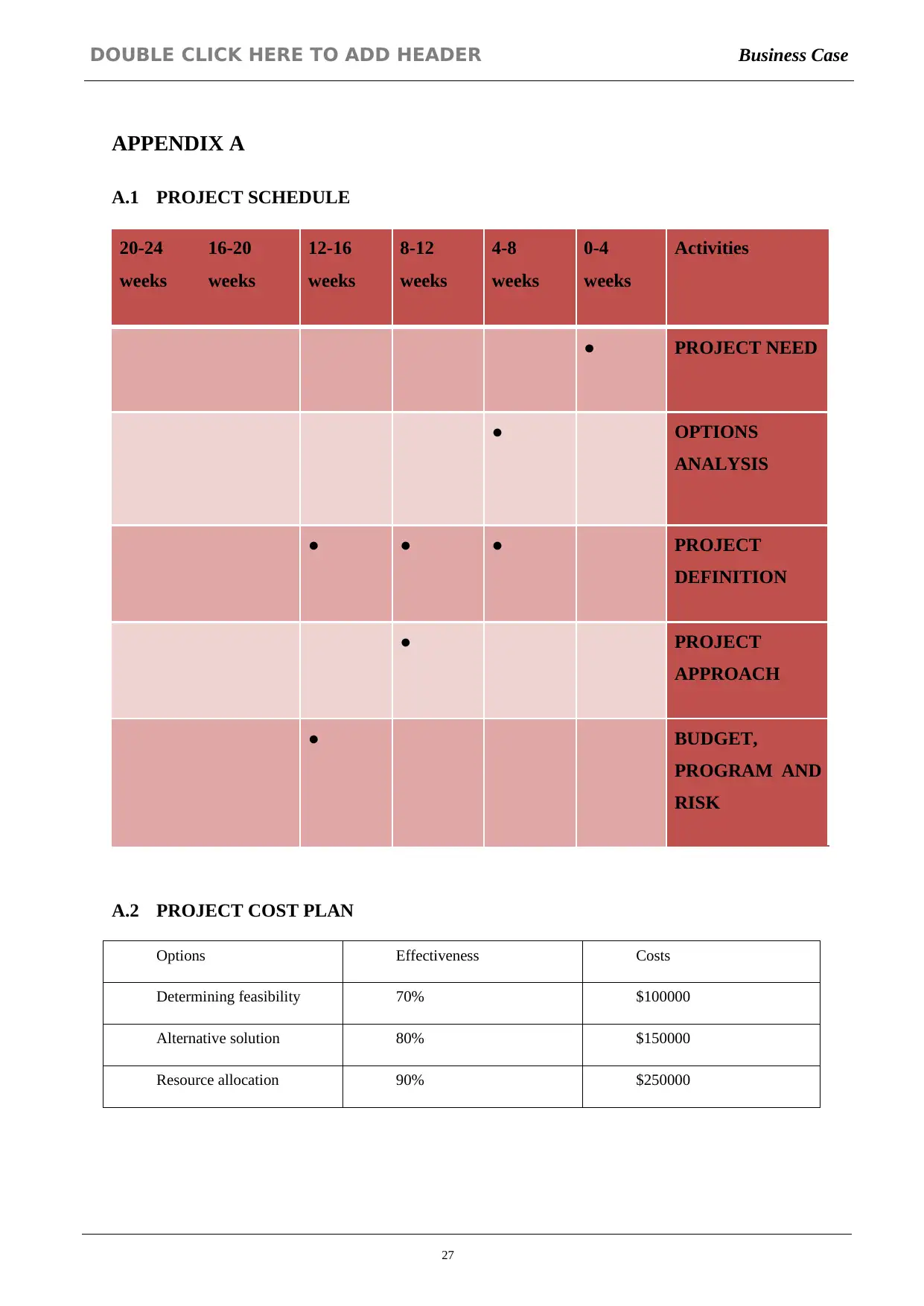
DOUBLE CLICK HERE TO ADD HEADER Business Case
APPENDIX A
A.1 PROJECT SCHEDULE
Activities0-4
weeks
4-8
weeks
8-12
weeks
12-16
weeks
16-20
weeks
20-24
weeks
PROJECT NEED●
OPTIONS
ANALYSIS
●
PROJECT
DEFINITION
●●●
PROJECT
APPROACH
●
BUDGET,
PROGRAM AND
RISK
●
A.2 PROJECT COST PLAN
Options Effectiveness Costs
Determining feasibility 70% $100000
Alternative solution 80% $150000
Resource allocation 90% $250000
27
APPENDIX A
A.1 PROJECT SCHEDULE
Activities0-4
weeks
4-8
weeks
8-12
weeks
12-16
weeks
16-20
weeks
20-24
weeks
PROJECT NEED●
OPTIONS
ANALYSIS
●
PROJECT
DEFINITION
●●●
PROJECT
APPROACH
●
BUDGET,
PROGRAM AND
RISK
●
A.2 PROJECT COST PLAN
Options Effectiveness Costs
Determining feasibility 70% $100000
Alternative solution 80% $150000
Resource allocation 90% $250000
27
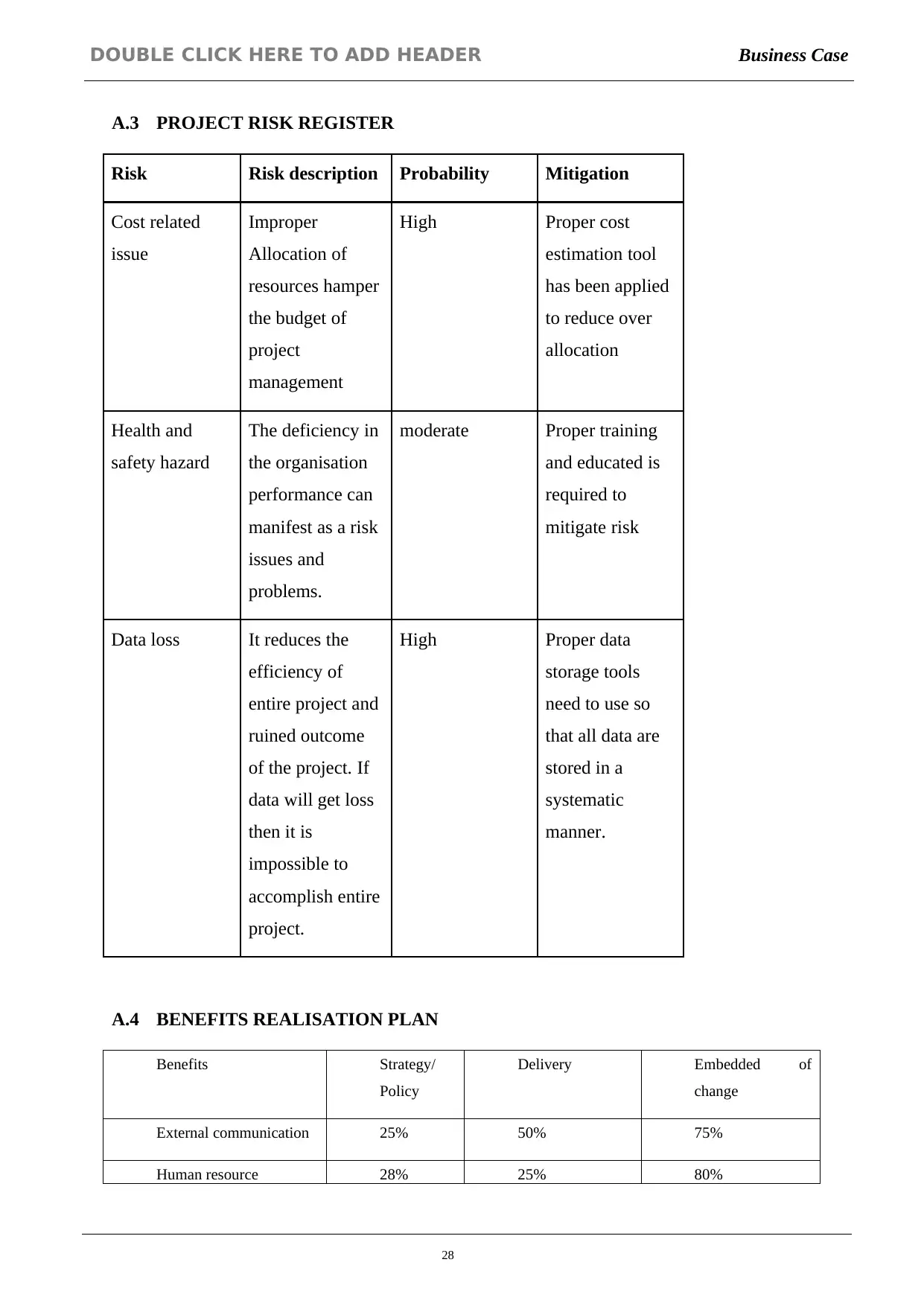
DOUBLE CLICK HERE TO ADD HEADER Business Case
A.3 PROJECT RISK REGISTER
Risk Risk description Probability Mitigation
Cost related
issue
Improper
Allocation of
resources hamper
the budget of
project
management
High Proper cost
estimation tool
has been applied
to reduce over
allocation
Health and
safety hazard
The deficiency in
the organisation
performance can
manifest as a risk
issues and
problems.
moderate Proper training
and educated is
required to
mitigate risk
Data loss It reduces the
efficiency of
entire project and
ruined outcome
of the project. If
data will get loss
then it is
impossible to
accomplish entire
project.
High Proper data
storage tools
need to use so
that all data are
stored in a
systematic
manner.
A.4 BENEFITS REALISATION PLAN
Benefits Strategy/
Policy
Delivery Embedded of
change
External communication 25% 50% 75%
Human resource 28% 25% 80%
28
A.3 PROJECT RISK REGISTER
Risk Risk description Probability Mitigation
Cost related
issue
Improper
Allocation of
resources hamper
the budget of
project
management
High Proper cost
estimation tool
has been applied
to reduce over
allocation
Health and
safety hazard
The deficiency in
the organisation
performance can
manifest as a risk
issues and
problems.
moderate Proper training
and educated is
required to
mitigate risk
Data loss It reduces the
efficiency of
entire project and
ruined outcome
of the project. If
data will get loss
then it is
impossible to
accomplish entire
project.
High Proper data
storage tools
need to use so
that all data are
stored in a
systematic
manner.
A.4 BENEFITS REALISATION PLAN
Benefits Strategy/
Policy
Delivery Embedded of
change
External communication 25% 50% 75%
Human resource 28% 25% 80%
28
Secure Best Marks with AI Grader
Need help grading? Try our AI Grader for instant feedback on your assignments.
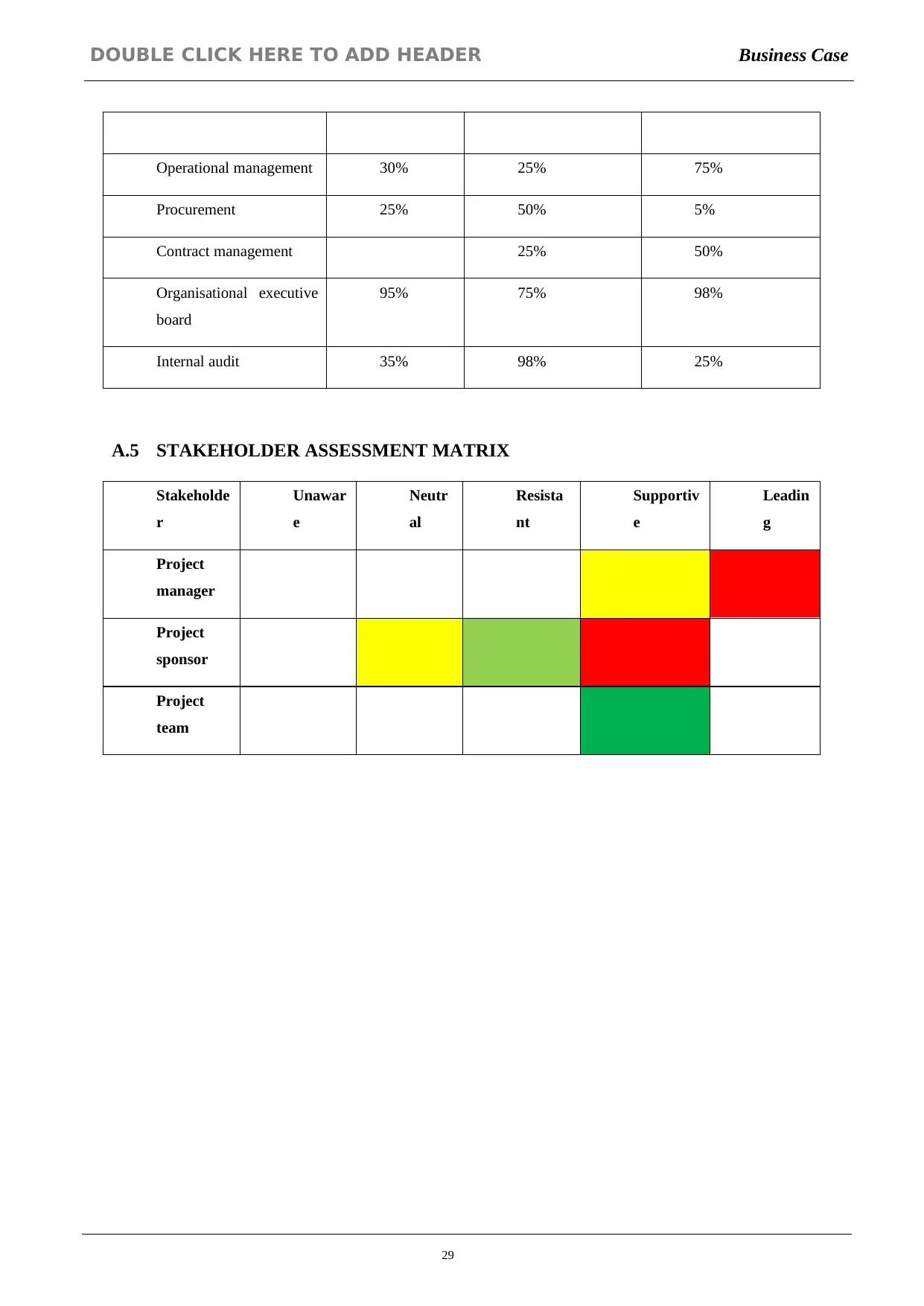
DOUBLE CLICK HERE TO ADD HEADER Business Case
Operational management 30% 25% 75%
Procurement 25% 50% 5%
Contract management 25% 50%
Organisational executive
board
95% 75% 98%
Internal audit 35% 98% 25%
A.5 STAKEHOLDER ASSESSMENT MATRIX
Stakeholde
r
Unawar
e
Neutr
al
Resista
nt
Supportiv
e
Leadin
g
Project
manager
Project
sponsor
Project
team
29
Operational management 30% 25% 75%
Procurement 25% 50% 5%
Contract management 25% 50%
Organisational executive
board
95% 75% 98%
Internal audit 35% 98% 25%
A.5 STAKEHOLDER ASSESSMENT MATRIX
Stakeholde
r
Unawar
e
Neutr
al
Resista
nt
Supportiv
e
Leadin
g
Project
manager
Project
sponsor
Project
team
29
1 out of 29
Related Documents
Your All-in-One AI-Powered Toolkit for Academic Success.
+13062052269
info@desklib.com
Available 24*7 on WhatsApp / Email
![[object Object]](/_next/static/media/star-bottom.7253800d.svg)
Unlock your academic potential
© 2024 | Zucol Services PVT LTD | All rights reserved.





